I took poetry and writing for my last course at SFU. I am not a poet, but I did over the course of the course learn much about writing in new forms, new ways to communicate, ways that were more open to interpretation, more visceral, more nuanced and, more engaging for the reader. This is the final paper.
First Stage. The Camino de Santiago, 800 kilometres.
St. Jean Pied du Port, France September 16, 2013
The Camino de Santiago, the Way, is a famous Christian pilgrimage. Folklore says the headless body of Saint James was miraculously found by a shepherd, guided by a star, in the 9th century, somehow mysteriously transported there from the Holy Land centuries before. Sound familiar? Santiago Cathedral, the venerated mausoleum of Saint James’ body, became a pilgrim destination. These days, Popes walk back the dubious myth of Saint James’ miraculous discovery, the story defies logic, geography and history. Pilgrims still come; 250,000 a year.
Departure – September 17, 2013
The jumping off point is Saint Jean Pied du Port, on the French edge of the Pyrenees. A night of no sleep – nervous, manic energy, anxiety, fear of failure, pack/repack, fidget and fret.
The first day is a test of determination, training, desire and grit – a hard 25 kilometre slog over the Roncevalles Pass into Spain. Rain, fog, wind, mud; a slap in the face, no extra charge.
Near the pass, a brass plaque signifies the battle, mythologized in the Song of Roland, where the Christian knight and his crusaders were caught and slaughtered by the Moors as they retreated into France in the 8th century.
Raincoats show their flaws, boots are sodden, packs become heavy, uphill is foreboding and constant, wind and rain are cyclonic. Reaching the hostel, persevering, becomes a quest; a shower, dry clothes, a hot meal and a warm bed await at the first Albergue, We’ve survived.
Along the Way – Finding the Rhythm
Walking consumes me, takes all my oxygen; I am obsessed, there is nothing else. It’s what I do, it’s the only thing I do.
Walking is,
weather is,
the Way is.
No trail finding skills necessary, no maps required, follow the signs.
Stay on the Way,
thirty days they say,
walk every day.
Routines emerge and harden; wake early, pack up gear, gulp a hot, bitter coffee, grab a pastry and set out; sunrise is best. When the sun is high, stop for second breakfast, another coffee and another pastry. Walk to day’s end, the chosen Albergue. Check in, unpack, shower, wash today’s clothes, put on tomorrow’s, rehydrate, nap, stretch. Commune with pilgrims; where are you from, why are you here, how are you feeling? Dinner is at 7, everyone is asleep early. Do the same for as many days as it takes to arrive at the Cathedral, to pay homage to the bones of Saint James that aren’t the bones of Saint James.
Fill the Void
Life on the Way is a void, no distractions; the outside world has ceased to exist. I walk alone.
The silence, the emptiness, the lack of distractions create a void unlike anything experienced; the void demands to be filled. It is. Wild fennel grows along our path; I rub its seeds in my hands, rewarded with the pungency of dill and anise, indelible, now forever the smell of the Way. Sunflowers offer a canvas to passing pilgrim artists to create happy faces to tickle my whimsy.
Early mornings are exhibitionists; the air is cool and fresh, the sky still filled with stars, sometimes a waning moon shines so brightly that my headlamp is superfluous. Mists swirl and curl, delineating contours of the land with their ever-shifting shrouds. The sun consumes them, they evaporate, light fills the gaps, a nuanced colour palate emerges offering impressionist paintings, the real reward for early-birds.
Yellow arrows become luminous neon signs. Each day’s first familiar arrow on a wall, a curb, a pole is my reassuring security blanket; I’m on the Way!.
Crowing roosters, cowbells, church bells off in the distance add melodies to my morning reverie. We walk from church to church, rest stops full of aged piety, sanctuaries of quiet contemplation, a vesper service in the evening, a cool oasis from the energy-drained afternoon slog.
Fellow Pilgrims
We are pilgrims for a reason, each searching for something different; some not admitting, most not knowing, what we seek, what we need, what we want, what to hope for. Something other than the bones of Saint James calls to us.
People insinuate themselves into my solitude. A troupe from PEI skips along like a traveling minstrel show, team t-shirts, a different color every day.
Three women, Birthe from Denmark, Jennifer from California and Sally from Victoria, bond like sisters in a day. Sally celebrates her 65th, I’m invited to join.
Jeanette, a petite grandmotherly woman in her 70’s, looks more at home in her kitchen. She lost her husband; rather than sink into mourning, she decides the Way is the way out. Her electric bike, her Rocinante, takes her to Santiago. Over a pilgrim dinner; she tells of sadness slowly being replaced by hope and joy. We meet again in Santiago; we hug, I shed a tear, lifted up by all that she is and all that she will be. Buon Camino.
Arrival – October 15, 2013
Arrival is sweet/bitter. The sweet is joyful, euphoric – deeply satisfying. Gratification, much delayed, is at hand. Attendance at the daily pilgrim mass in the Cathedral bookends the Way: closure, my exclamation point. Priests swing a monstrous cauldron of burning incense down the length of the cathedral and back; rumour has it the incense tradition was started to cover the malodor of pilgrims.
The comes the bitter. It’s over; the void opens, I look into the abyss.
Peggy Lee emerges, stage left, singing “Is That All There Is?”.
No grand epiphanies, no insights into my soul, no nostrums on to how to lead ‘the good life’. The true gifts are the kindness of strangers, quiet, finding comfort in aloneness, a reconnection to the simplicity of nature, reawakened awareness of tiny pleasures, the physicality of walking, gratitude for gifts unexpected.
Second Stage – the Camino Portugues – 600 Kilometres
Lisbon, March 1, 2015
The Camino Portugues is a 600 kilometre pilgrimage from Lisbon to Santiago; it is sparsely traveled, fewer than 1000 pilgrims a year, lacks convenient amenities like hotels, hostels, restaurants, compensated by good signage, hospitable people and bread, extraordinary bread.
Slow down, again.
Spring in Portugal is idyllic, sunny and cool, farmers are in the fields, trees are blossoming, flowers are blooming, birds are singing. The pungency of fresh pig manure offset by the earthiness of freshly plowed soil ignite memories of a small-town in Alberta, long ago and far, far away. The scent of the baker’s fresh bread at the edge of the village; I sniff it out like a hunting dog. Again attuned to the delicate sensual possibilities of my surroundings. Dawn brings the morning dew, that dew captured on a spider web in morning’s soft golden light reveals its intricate architecture. My crowing roosters, my cow bells mingling with my church bells.
There is no clock but the sun, I lunch when the locals stop; their food, at their pace, leisurely, with appreciation. A park bench for siesta as the shadows grow in the afternoon.
Alone not Lonely.
Walking offers solitude; the emptiness opens room for awareness of the delicate, the whimsical, the ethereal. Without distractions, with abundant time to meander, my mind wanders further afield, seeks out distant recesses, rediscovers oft-forgotten memories. The interior space offers its own amusements, contemplations, dreams. The Knights Templar, a Catholic order of the 12th and 13th centuries, the Church’s warrior monks had their own castle in Tomar. Envious Kings and Popes disbanded the order, took their money, hunted them as fugitives. I create stories of those Knights Templar; heroes of my dreams, I join them for an adventure.
In the Company of Strangers
Evenings are amenable to the company of strangers, evening meals break the fast of aloneness. We walkers, it seems, are more honest, more revealing, more vulnerable, more open to dialogue. We gather for the pilgrim meal; a young man arrives in a flurry, late. A cyclist with wild Rastafarian hair, a bit ragged around the edges, a vast array of tattoos; my privileged white man bias tags him as an English Football hooligan. I name him Hooligan Harry.
“Oh great,” I think, “another night at the Bates Hotel”.
Our ragtag pilgrim group morphs into a fraternity of fellow travellers. Past travels, recent adventures, the philosophy of life, religion, football, human discourse at its best. Hooligan Harry is transformed into Renaissance Harold, a modest, thoughtful carpenter on a two year drop-out bike trek. Note to self, be aware of the fallibility of quick judgements.
Ruts as old as time.
The pilgrim path follows the Via Roma XIX, created by the Romans in the first Century AD; a path so eroded by the passage of feet and time, now several feet below the surface of the forest. Bridges built centuries ago, repaired, provide pilgrim’s crossing connecting an age-old road: my trek again shared with the Centurions.
Tender Mercies
In silence, uncluttered by noise and sensory overload, I become aware of nuances, subtleties and pleasures of human interaction, the kindness of strangers. I call them Tender Mercies. Drowned out in normal life, Tender Mercies are the oft-passed over, gossamer soft, fleeting, under-observed kindnesses of strangers brought to life. I catch them in the net of my empty mind. I play with them, shine them up, build stories around them, place them on my mind’s mantel, save them for special moments of remembrance. Later, as I roll them over in my brain, they bring smiles, driving away the lows, the sadness and the darkness.
In Golega, the O Te restaurant/hotel, I’m refreshed by a second floor room, a suckling pig dinner, a morning espresso and insightful philosophical musings from an elderly French Moroccan who somehow ended up as a hotelier in rural Portugal.
Miguel and Jennifer introduce me to Porto, their beloved city, an excursion ending with a match at FC Porto – futball, the other religion of Portugal.
At Meson Pulpo, near San Amaro, I stop for my late morning coffee. Filled with warmth, I decided to rest, absorb the serenity, eat. I order a bacon bocadillo – such lovely words, bacon bocadillo – I taste the words, even before it arrives. I savor my bacon bocadillo, the aroma of the soft chewy bun, the crunchy, hot, greasy, salty, bacon.
This restaurant is their home. I was their guest, radiant in their kindness, warmth, generosity, calm. Reluctant to go, reluctant to see me leave. That moment, my only human contact of the day; these are Tender Mercies.
There are sweet spots, fireflies of bliss, frozen in a minute. Ponte de Vila; a town of sublime beauty, shows deep respect for its history mixed with surprising modernity. Portuguese bread. Fresh fish, every piece cooked to perfection. Portuguese tiles turn buildings into art. The Portuguese tortilla, elevating potatoes to their rightful place as national cuisine. Bacon Bocadillo! Sweet spots, brief magical moments over which pixie dust is sprinkled. They don’t arrive easily; they last forever, their fleeting evanescence filling my mind’s void.
Third Stage – 88 Temples – 1400 Kilometres
Takushima, Shikoku, Japan April 1, 2016
The 88 Temples pilgrimage honors Kobo Daishi, a 10th century Japanese monk, instrumental in bringing Buddhism to Japan. 150,000 pilgrims annually replicate his travels. Daunting. A walk through time. A meditative search for Buddha. A stroll through rural Japan. Daunting, indeed.
Becoming a Japanese Pilgrim.
A Henro, a pilgrim, dresses to celebrate the ritual of pilgrimage. Requirements:
– a light white cotton vest/jacket representing purity and innocence.
– a sugegasa, a sedge hat, a portable, hands-free umbrella, protection from rain and sun, surprisingly comfortable.
- the kangozue, a long wooden walking stick topped with woven silk and a bell. Kobo Daishi’s spirit walks with us in our staff. It must be cared for, cleaned after every walk,
- – a Zudabukuro, a shoulder bag to carry candles, name slips, coins, incense sticks, and my precious stamp book, to honour temple rituals.
– an ample supply of curiosity, humility and gratitude.
I have no north star, no compass, no past experience, as close to explorer as today’s connected world allows.
Temple Serenity.
Each temple is unique, yet certain rituals are universal. Usually, after climbing stairway after stairway, the Henro reaches the gate. Henro pauses and bows, enters the temple grounds. To purify, Henro washes hands at a ceremonial basin, sips/spits a bit of well water to cleanse the mouth to enter the temple free of the dust of the journey. At the bell tower, Henro rings a massive brass gong – just once, more is bad luck. In the main hall, a name slip on which is written a short prayer for loved ones, is placed in a box. Three sticks of incense and a candle are lit and a donation placed in the offering box.
Henro becomes me. I say my prayers. I pause. There is a colour, a purple, that is so regal I automatically bow to it, subjecting myself to its majesty. If I am fortunate, other pilgrims are chanting sutras, magical, lilting songlike. I listen, eyes-closed, transfixed, transformed and transported to another time, another place, another world. Still in the sutra’s aura, I sit quietly, solemnity seeping into my bones, a singular peacefulness, a warm blanket of serenity.
I rouse myself, meander over to the Buddhist monk on duty, receive my temple stamp certified by a magnificent elaborate calligraphic flourish. We smile, acknowledge each other, a gift as valuable as the stamp. Exiting the temple, I bow to say goodbye.
The privilege of Pilgrims.
On a cloudy morning with rain a definite likelihood, I walk through a small village, approaching a tiny elderly woman pushing her rolling portable chair. Stooped over, her back carries a lifetime of toil, of hand-planting a million rice shoots one-by-one. She looks at me, I pause and bow. She glances at the sky, I look up too. She looks back at me. I look back, respectfully. She holds up her umbrella and gestures for me to take it. Smiling, I shake my head no. We engage in a non-verbal test of wills. Will I take her umbrella? How can I take her umbrella? How can I say no graciously? She insists! I can’t take her umbrella. Finally, to break the impasse, I walk over to her, bow many, many times and give her a Canada pin. I refuse the umbrella, politely but firmly. We reconcile, we bow. I wander off, marveling at her aggressive generosity.
It doesn’t rain.
A bus driver adopts me, foreign Henro, abandons his passengers, jumps out of his bus and shows me where I need to go, patiently waiting till he’s assured I’m on the right path. His passengers don’t seem to mind.
A man sees me walking past his home, rushes out, chases me down the street, catches me, bows, presents a small glazed clay pilgrim statue to carry on my pilgrimage.
The Japanese might have invented Tender Mercies.
For the love of blossoms
Blossoms burst into view, deep lipstick pinks, soft pastel white-pinks, every hue in between; across the field, a single cherry tree blazes pink amidst a forest painted the special greens of newly unfolding leaves, too many shades of pink and green to calibrate, each an affirmation of vitality and promise. Irises everywhere, splashes, slashes of brilliant purple accentuate the greens and pinks. At temples, umbrellas protect flowers from the rain so they may blossom fully. In the forests, bamboo, gently wave in the wind, next to pine trees that barely waver.
Japanese Koi nobori – elongated, hollow, multi-coloured kites on high poles wave in the breeze – part streamers, part kite, part flag, funny carp-looking streamers swimming in the blue wind – spring’s hopes in a kite.
Japanese farmers, artisans of the earth, meticulously manicure their plots: they work the soil, rice planted here, winter wheat ripening there, bags of onions harvested alongside Japanese radishes, a few frogs, two snakes.
Small plots where mechanical planters immerse tender shoots in water without maiming them; infinitely superior to one-at-a-time hand planting. Derelict houses witness the exodus of young people to the city, neglect amidst the farmers’ verdant crops.
Mountain paths, misty and mystically enhanced by aged Buddhist and Shinto monuments, stand silent, commemorating centuries of walkers. Paths are littered with monuments and statues, many adorned with brightly coloured knit caps, bibs and capes; offered up to the gods to keep them warm and save them from chills. Graveyards with ancient headstones – Shinto shrines – placed long before and long after Kobo Daishi and his Buddhism encroached, speak for another, more animist, religion, silently resisting the Buddhist invader.
Home not home.
Traditional Japanese hotels, ryokans, offer a simple room covered with Tatami mats, futons on the floor for sleeping and a toilet/sink. It is easy to go to bed, just flop down and pull the covers over you. Getting up is tougher. Done in stages, stiff muscles roll over onto all-fours, kneeling, lifting, finally upright, noisy and ungainly. Thankfully there are no witnesses.
Toilets designed by a techno-madman; a terrifying array of buttons offering options to do things to my bottom that are unimaginable. I touch none, barely trusting the normal flush lever.
Several pairs of slippers are provided, guests remove street shoes at the door and put on floor slippers, then remove floor slippers to put on room slippers; there’s usually a special pair of bathroom only slippers. No exceptions. Do not mix them up.
Onsen, Japanese communal baths, require special tourist courage. Segregated but public, very public. I wash, thoroughly, publicly, noisily, nakedly with the rest of the male bathers, then I bathe with them – again naked. Like the water, it is all too hot. I retreat to my room, red-faced but cleansed. This home doesn’t feel homey.
Food for the Epicurious
Meals are for the epicurious. Rice, salad, soup, fish bits, pickled vegetables – breakfast at the traditional Japanese hotels. Foraging for lunch is more familiar. Convenience stores, astonishingly, offer fresh full nutritious meals for the pilgrim walker. Lawson is my favourite, offering food, an ATM and wifi – sustenance, cash and contact with home, convenience redefined. Restaurants offer pictures and odd little plastic replicas of the dinner menu items. Sushi is my mainstay; the sushi-chef in his special jacket, shirt and tie is king. I give him respectful license to feed me, he’s never wrong.
Visual presentation and display are carefully considered. I am advised to pause a few minutes to observe and take pleasure in the beauty of my food – art enhances the dining experience.
Koyo-san
The Buddhist monk stamps my book, my 88th stamp, signs it with his elaborate calligraphy. I’m done. I give my staff to the caretaker, they are ceremoniously burned as a sacrifice. A new pilgrim in my hotel takes my sedge hat, the rest of my uniform and my stamp book are mine. I board the bus to Koya-san, a temple rich village in the mountains above Kyoto to pay respect to Kobo Daishi. He is here, in eternal meditation. Eternal meditation sounds so much more dignified than death.
Down and done
It’s not all fun and games. I’m drained. I spend my last few days in Kyoto, drinking coffee at Starbucks, reading the International New York Times, eating egg salad sandwiches, listening to a Japanese curated playlist of best American hits of the 50’s and 60’s, trying to cover myself in a warm blanket of the familiar till Air Canada takes me home.
Fourth Stage – The Via Francigena – 2000 Kilometres
1 – Canterbury, England – Reims France July 16, 2017
2 – Reims, France – Ivrea, Italy July 16, 2018
3- Ivrea, Italy – Lucca, Italy, September 2, 2021
4- Lucca, Italy – Rome, Italy, April 16, 2022
In 990 AD, the Archbishop of Canterbury, Sigeric, walked to Rome to be confirmed by the Pope as a Cardinal, his return trip chronicled, 79 stops preserved on a single sheet now preserved in the British Museum. His journey inspired the Via Francigena. With only 2500 pilgrims annually, it’s a lonely walk. Yet, through the years, through invasions, wars, the plague, predation from two and four-legged animals, scorching summer sun, freezing Alpine passes, pilgrims have endured, walking to Rome to seek enlightenment, forgiveness of past sins, healing.
Motivations as varied as the human condition.
The comfort of the familiar
After Japan, walking the VF is like putting on a pair of old slippers. My pack is light, I have my guidebook, my passport and my credit card. My old routine still works, a study in positive addiction. I rise, eat, drink and walk – stay on path, observe the scenery and its minute miracles. Hours of mindful vacancy are my familiar rewards. It feels good. Another day done, I dump my pack, wash my clothes, eat simple French rural food at its best. I sleep well.
I am where I want to be, walking my path, reacquainting myself with tiny miracles of a flower, a sunrise, mist, cool water, a simple buttered baguette, a wave to the locals as I pass through near abandoned villages,
Walking through History.
Kristen is with me for a while. In northern France, remnants of the great war share their horrors. A small cemetery, populated with random crosses – French, Belgian, English, German, an occasional Canadian define the losses at a field hospital. Hospitals at the front took anyone brought to them; death took its share, they were buried together without discrimination. Here no one was friend or enemy, no one won – war’s cruel egalitarianism.
Bapaume has a Sunday circus. Serendipitous surprise, we arrive in time for the parade! We drop our packs, find French profiteroles, carny pastry at its best and pull up a piece of curb to watch – unexpected, enthralling entertainment. We saw camels!
Villages, hollowed out by farm consolidation, efficiency and the inevitable migration to cities, leave only the elderly and the stubborn; a rich tapestry of rural French life gone – old people, old ways, churches decimated of congregations, priests and abandoned beliefs. The ultimate indignity, a bread dispensing machine – even the fresh baguette has been forsaken.
Much is left to appreciate; rolling hills, the wheat fields golden, heavy and ready for harvest, a donkey shocking us with his ungodly bray, the sheer joy of walking, the blessing of companionship, the connection with weather, land and the ground beneath our feet. The simple joy of a ham and cheese baguette, a drenching summer rain showering our sense of humour, the celebratory glass of champagne for my daughter/companion, the pride of accomplishment in achieving something that can only be gained by one measure – footsteps.
Reims, the city of kings when kings mattered, is now more famous as the home of Champagne; more venerated than generations of kings buried at the Cathedral.
Walking alone or together.
I travel alone, pilgrim journeys are solitary by choice. Alone does not mean lonely, one does not have to be an introvert to realize that some activities are best experienced on one’s own. It’s called being comfortable in one’s own skin.
A proper companion adds to solo walks. My daughter Kristen and I walk well together; long silences, mutual chatter, a few deeper conversations, some code-talk decipherable only to us, years and years of old dead-cat bounce jokes.
On the next leg my friend John walks with me from Reims to Besancon. The perfect walking companion, quiet till he has something to say, amiable to a fault, pleasant dinner companion and roomie, adding bright and shiny observations, new dimensions, to the journey.
A summer heat wave defines this walk. Hollowed out rural France limits our options, access to water becomes an overarching necessity, finding sanctuary in shade – straw hats, a tree, the cool church – weather rules at 30+ degrees. We hitch rides, hire taxis, start earlier, anything to reduce our walking time under the relentless sun and heat. The pavement softens.
Up and Over
The Great Saint Bernard Pass is the halfway point of the VF. A Roman gateway to Europe before the birth of Christ; Napoleon marched back to attack the Italian city states in 1800. At 2473 metres, it is formidable; travel by foot is only possible in July and August.
Blair joins me in Lausanne, five days up to the top of the pass. It’s not easy. I struggle, grateful for his presence, his support and his encouragement. It’s always a test of will over wish.
Late afternoon, within sight of the summit, Blair surprises me. We find a flat rock, drop our packs, sit; he pulls two Astronaut-ready freeze-dried ice cream sandwiches from his pack, feeding my legendary love of ice cream. We sit on our rock, basking in the sun, and savour our treat. Priceless.
Icing on the ice cream, a young woman appears, out for a walk with three Great Saint Bernard dogs, sent by the gods to guide us through the Great Saint Bernard Pass.
Pandemic interlude
If you want to hear the gods laugh, tell them your plans for the future. Life’s distractions necessitate a year’s delay; then covid closes all doors. We hunker down; a trip to buy groceries becomes unthinkable, Italy, impossible. Doubt creeps in, fear its companion. Anxiety and the desire for safety inflates risks, problems, what-ifs. Lethargy kills dreams. Months of whiling away hours, the only goal being to while away the hours. Has the joy of adventures lost its joy?
A window opens in autumn of 2021. Italy’s vaccination rates are high, infections are down, hospitalizations down, deaths down. Travel restrictions are loosened, BC immunization cards are recognized by Italian authorities. Walking in rural areas with minimal contact with others; no more hostels, my own hotel room, tough Italian no-nonsense rules. Needless risk is not smart, minimizing risk is. It’s worth the risk.
I have unfinished business, it’s time to go.
Italy – fountain of renewed faith
Ivrea to Lucca; down out of the Alps, across the Po valley, over the Apennines, into Tuscany – 450 kilometres in all. The Po Valley is famous for growing risotto, a signature dish for Italian cuisine. Rice growing requires flooding; water being what it is, flood irrigation requires flat land – relentlessly flat land. A complex grid system of canals, ditches and sliding gates has been created to ensure the channeling of river water across vast distances to irrigate the valley, a massive engineering project worthy of the plumbers who brought us aqueducts 2000 years ago. Flat is good for walkers.
Familiar ways of seeing
The Po Valley offers rural ambling at its best, especially early mornings. The misty coolness, the scent in the air, surprised little beasties – rabbits, feral cats, cranes and herons, a dead snake. The dew on slender stalks of grass, the amazing light as it plays across the sky and the land; dark turns to dawn, dawn turns to morning. It is the magical part of the walking day. It’s also practical; the earlier the start, the sooner the finish – and out of 30+ heat. The now familiar rhythm of pilgrim walking is satisfying. Elemental, simple, rustic, like meeting an old friend.
Covid anxiety drains away like excess water into the channel.
My Passport
In Tromello, I stop for my morning coffee. While I’m resting in the small central square of this village, a spare, elderly man rolled up on an equally aged bicycle.
“Pelegrino?” He asked.
I nodded.
“Passport?”
I nodded again.
He motioned that I should give it to him.
I did.
He rode off.
Pelegrinos carry a pilgrim passport. We collect stamps from hotels and churches to verify our passage. It’s like getting stars in your school workbook. It’s oddly satisfying.
In a few minutes he returned, his church stamp proudly displayed in my passport forever.
“Buon Camino.”
Grazie mille.
We finished the formalities, smiled to each other,
Off he rode.
Such Tender Mercies…
Crossing the Po
Danillo has been running a ferry for pilgrims to cross the Po for 23 years. He is a legend; ferry boat captain, historian of the VF, certifier of passage and keeper of the Big Book. The night before our crossing, I stay at the hostel in Corte S. Andrea right beside the Po River. There is an Osteria close by; it’s Sunday, long Sunday family lunches are a tradition. I arrive unannounced, bedraggled; a table is set up, I’m fed like a prince. They give me the hostel key, I wander over, find a bed. Giovanni and his wife, voluntary caretakers both in their 80’s, pop over to welcome us. Kindness isn’t always large and dramatic, sometimes it’s daily and small.
Next morning we meet Danillo. Well into his elder years, he captains his boat across the Po, ferries pilgrims, offers a history lesson and permits us to sign his pilgrim ledger, the Big Book.
It leaves passengers giddy.
Over the Apps.
The Appenines are the last serious elevation on my way to Rome. Wild animals set paths long ago that followed contours, not losing elevation unless necessary. Smart people followed the animals, turning their trails into paths. VF planners ignore contours, plot a bizarre path with needless ups and downs. I follow contours, plot shortcuts, muttering vile threats. I hope I’m right.
First day is 20 km with about 1000m of elevation. After an early morning train ride, I reach my B&B, check in with Manuella, drop the Beast and manage to make it to Cassio. I am grateful that, after much huffing and puffing, vehement curses on the heads of route planners and a brief storm, I arrive in time for my afternoon espressos. The local bus arrives, I make it home In time for a shower and dinner. Slick! Damn I’m good!
Day two is shorter, 10 km and 300 m of elevation. Saturday, only a few buses run. I hitched a ride to Cassio, did my walk to Bercetto and caught the ONLY bus back home – again in time for dinner.
Hah! Easy peasy!
Third day, there are no buses on Sunday! Major tactical flaw, no plan B.
Crap. What now!
Manuela, my saviour, manufactures a new plan and we move; she calmly feeds me breakfast, drives me to Bercetto, drops me off at my B&B, perfectly positioned for my final day. In doing do, she sacrifices hours of time, a busy B&B and kilometres of driving to move me forward. The final day, I quick-march to the summit, stroll 22 kilometres downhill to Pontremoli.
Victory achieved. That wasn’t so bad, I think. Why was I so worried?
It was Manuella who made it not so bad. She rescued me, the saint of Tender Mercies, proof again that one doesn’t always walk alone, that ups and downs can be navigated by following the contours.
Wading through Italian history.
A walk to Lucca is a walking history lesson. The landscape, rolling hills and valleys, rugged forests broken occasionally by pastures and crops, strung together by small villages. Pontremoli, a fortress town controlling access to two valleys and lands above and below for centuries, houses a museum of stele discovered nearby dating back to the 3rd/ 4th century BC.
Filleto, a fortress of its own, is Saracen, another word for the Moors – invaders, bandits and raiders who dominated much of the Mediterranean for centuries.
After Filleto, I walk a road that dates back to the Roman Empire. With everything measured in seconds and sound bites, to walk the footpath Roman armies used to cross the Alps more than 2000 years ago, used for so long that the road is sunk several feet below the forest floor brings perspective to the quicksilver of immediacy.
Luna offers proof that Carrara marble has been used from Roman times. Carrara quarries are famous since the golden age of Rome; Michelangelo’s David, marble from Carrara, has the unsurpassed purity of the white Carrara marble.
Saint Michele Paolino Cathedral in Lucca, fittingly clad in Carrara marble, I receive my pilgrim stamp, the end of this section. The final walk, 350 kilometres fromLucca to Rome, is – like life – to be continued.
The Polish author, Ogla Tokarczuk, a Nobel Prize winner, develops her idea of synchronicity:
“…evidence of the world making sense. Evidence that throughout this beautiful chaos threads of meaning spread in every direction.”

















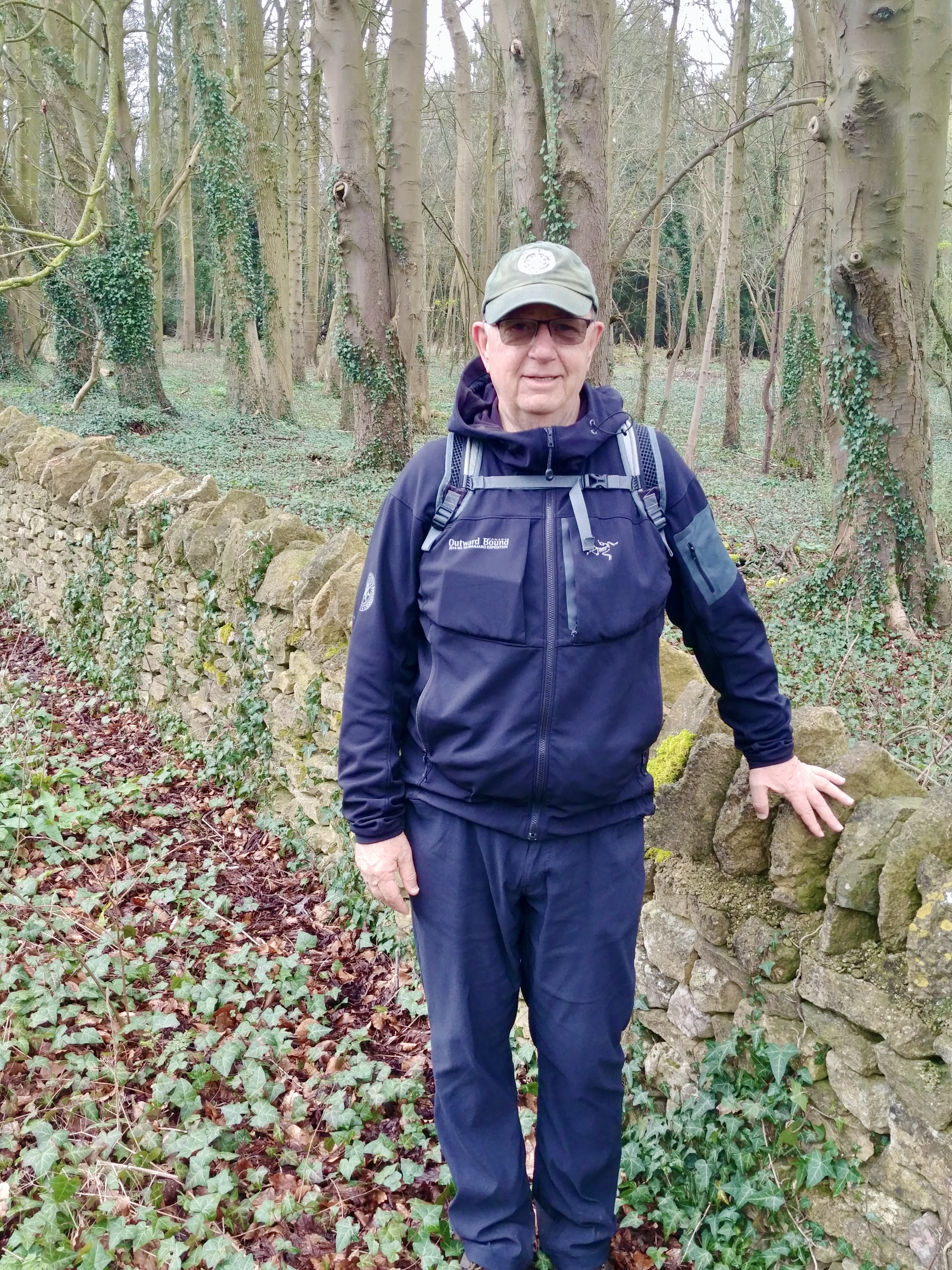 The land is portioned off by stone fences. Loose stone gathered from fields piled without mortar in a linked, orderly manner to be virtually indestructible. They go on for miles. They amaze me. I think the word is gobsmacked. I’m equally impressed by hedgerows, ancient tangles of bushes, virtually impermeable, a living home for rabbits and other beasties. Rural England fields, delineated by hedgerows and fences, are easily traversed however by right of passage paths; in most of the UK, a person can walk across a farmers field with impunity, although death-by-surprised/angered-cow happens more often that one might expect. It’s a Canadian hiker’s dream.
The land is portioned off by stone fences. Loose stone gathered from fields piled without mortar in a linked, orderly manner to be virtually indestructible. They go on for miles. They amaze me. I think the word is gobsmacked. I’m equally impressed by hedgerows, ancient tangles of bushes, virtually impermeable, a living home for rabbits and other beasties. Rural England fields, delineated by hedgerows and fences, are easily traversed however by right of passage paths; in most of the UK, a person can walk across a farmers field with impunity, although death-by-surprised/angered-cow happens more often that one might expect. It’s a Canadian hiker’s dream.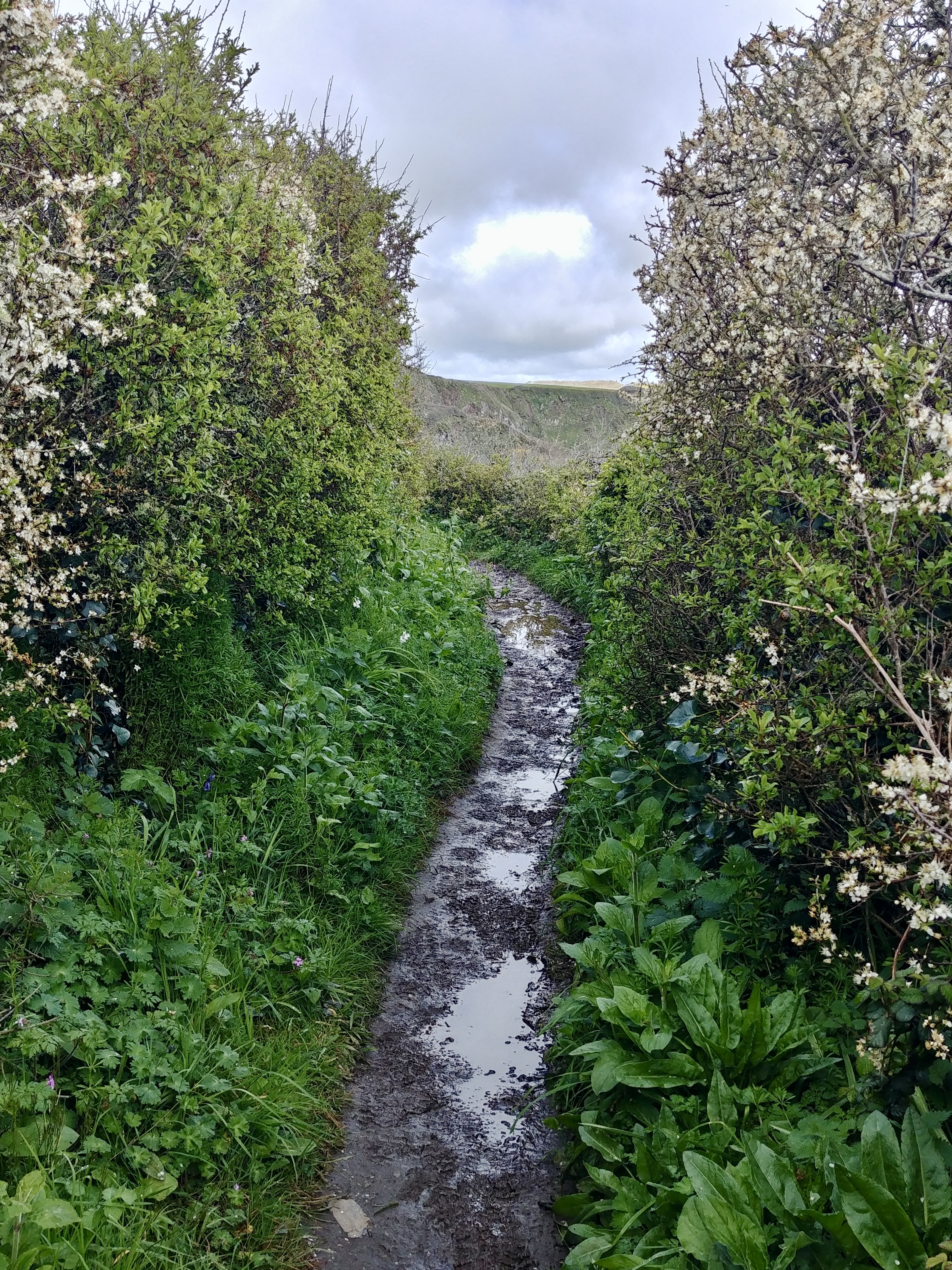 I’m also impressed by the quality of the mud here. March was the wettest on record in the Cotswolds. The Windrush river is high. Puddles abound especially around a plethora (love that word, had to use it; forgive me) of gates all ingeniously designed to befuddle sheep and foreigners. Foolishly, we try to stay clean and dry on our walks. A quarter hour in, I give up. Mud adds to the ambiance.
I’m also impressed by the quality of the mud here. March was the wettest on record in the Cotswolds. The Windrush river is high. Puddles abound especially around a plethora (love that word, had to use it; forgive me) of gates all ingeniously designed to befuddle sheep and foreigners. Foolishly, we try to stay clean and dry on our walks. A quarter hour in, I give up. Mud adds to the ambiance.  We stopped at a small village green for a standup lunch. There was a checkin for some local event close by so we wandered over to see what it was about. Think of a treasure hunt with multiple stops, the avid participants being vintage motorcycle owners. In England there is a club for almost every interest; all taken seriously, all pursued with joyous concentrated eccentricity. A perfect example appeared in a puff of smoke – a couple on a motorcycle and a sidecar rolled in.
We stopped at a small village green for a standup lunch. There was a checkin for some local event close by so we wandered over to see what it was about. Think of a treasure hunt with multiple stops, the avid participants being vintage motorcycle owners. In England there is a club for almost every interest; all taken seriously, all pursued with joyous concentrated eccentricity. A perfect example appeared in a puff of smoke – a couple on a motorcycle and a sidecar rolled in.  England is littered with history; celebrated, discussed and debated as if it still mattered. We casually visit small Norman churches that go back to the 12th century. Bourton-on-the-water is a perfect village, our home for the week, all golden cottages, picturesque pubs and stone bridges crossing the Windrush River, Upper Slaughter, a village close by even has a water wheel, still turning after all these years.
England is littered with history; celebrated, discussed and debated as if it still mattered. We casually visit small Norman churches that go back to the 12th century. Bourton-on-the-water is a perfect village, our home for the week, all golden cottages, picturesque pubs and stone bridges crossing the Windrush River, Upper Slaughter, a village close by even has a water wheel, still turning after all these years.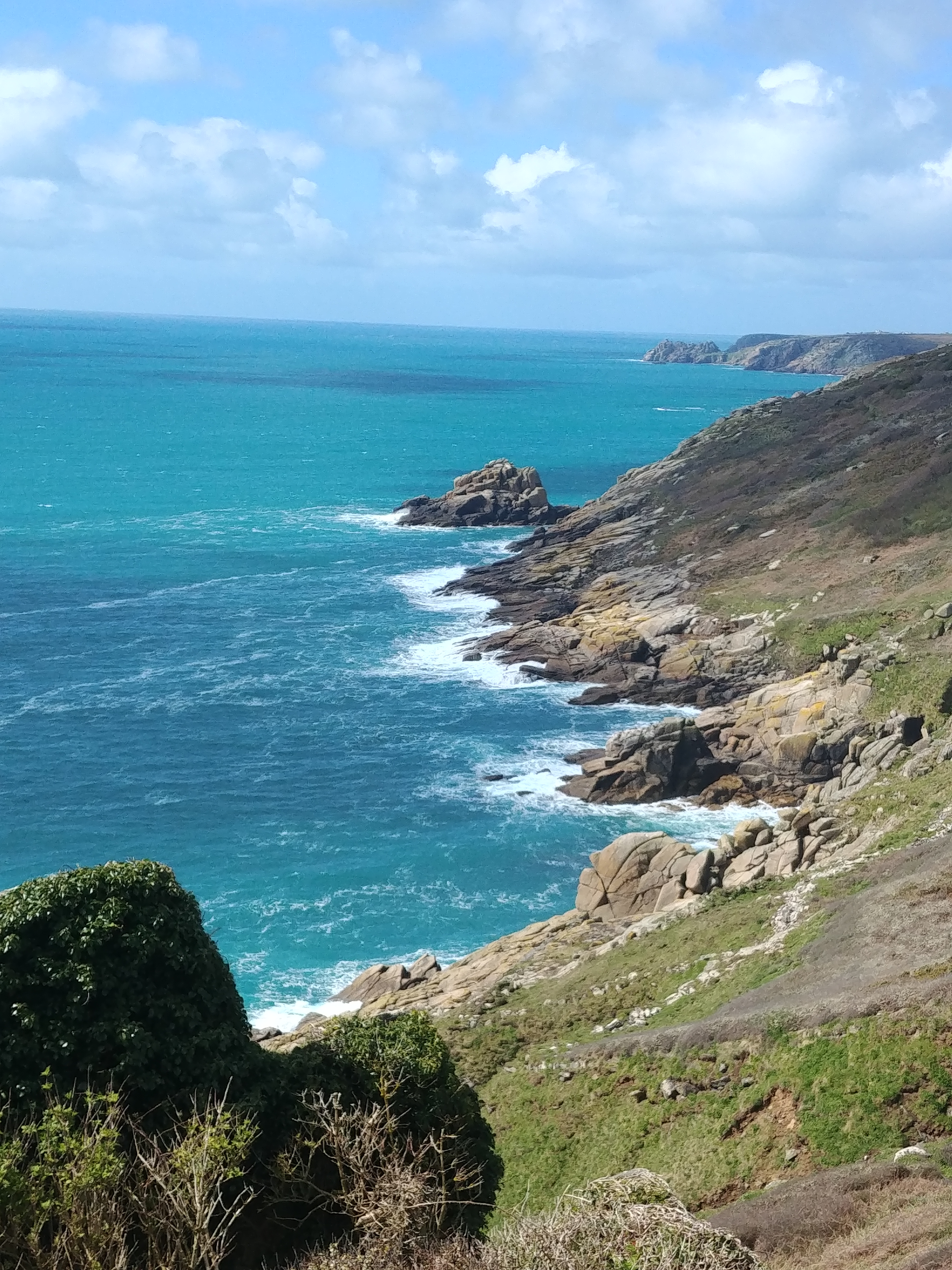 Next week, I exchange the rolling hills, quaint golden cottages and bursting-with-spring-green meadows of Bourton-on-the-Water for the rugged, wind-sculpted upsy/downsy terrain of Cornwall; defined by the ocean, cliffs and abandoned tin mines. It’s as desolate looking as the Cotswolds were lush.
Next week, I exchange the rolling hills, quaint golden cottages and bursting-with-spring-green meadows of Bourton-on-the-Water for the rugged, wind-sculpted upsy/downsy terrain of Cornwall; defined by the ocean, cliffs and abandoned tin mines. It’s as desolate looking as the Cotswolds were lush.  A slight digression if I might be allowed. At St.Just, I was compelled to sample my first.original pasty (pronounced with a soft ‘a’ like pasta). One cannot pass a shop that claims to be the oldest maker of Cornish Pasties. It would simply be wrong.
A slight digression if I might be allowed. At St.Just, I was compelled to sample my first.original pasty (pronounced with a soft ‘a’ like pasta). One cannot pass a shop that claims to be the oldest maker of Cornish Pasties. It would simply be wrong. Our walks along the Coast Trail are amazing confirmation of my desire for the experience. I choose the shortest of the daily walks – about 8 km. We ramble about for 4-5 hours, view the scenery, learn some fun facts, most of which I immediately forget. I have my own room, meals, a packed lunch and a guide. I am getting an April tan. I become mildly addicted to canned pork and beans on toast for breakfast, as close to a vegetable as I can find. The English still seem mystified about how to cook vegetables; Ottolenghi is trying.
Our walks along the Coast Trail are amazing confirmation of my desire for the experience. I choose the shortest of the daily walks – about 8 km. We ramble about for 4-5 hours, view the scenery, learn some fun facts, most of which I immediately forget. I have my own room, meals, a packed lunch and a guide. I am getting an April tan. I become mildly addicted to canned pork and beans on toast for breakfast, as close to a vegetable as I can find. The English still seem mystified about how to cook vegetables; Ottolenghi is trying. Stories abound of resourceful Cornishmen who, not looking forward to a nasty, brutish and short life toiling in a tin mine, took matters into their own hands and became experts at salvaging whatever drifted ashore from wrecked ships. While lighthouses did exist to guide ships away from rocks and harm, enterprising Cornishmen were known to create illicit lighthouses, carefully designed to lure ships onto the rocks. The Cornish version of Robin Hood.
Stories abound of resourceful Cornishmen who, not looking forward to a nasty, brutish and short life toiling in a tin mine, took matters into their own hands and became experts at salvaging whatever drifted ashore from wrecked ships. While lighthouses did exist to guide ships away from rocks and harm, enterprising Cornishmen were known to create illicit lighthouses, carefully designed to lure ships onto the rocks. The Cornish version of Robin Hood.  I learned new definitions for a couple of common words that impressed upon me the English capacity for understatement.
I learned new definitions for a couple of common words that impressed upon me the English capacity for understatement.


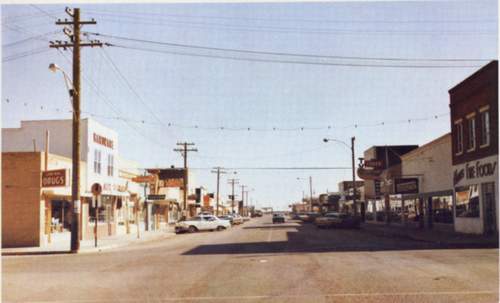 I grew up in a small town in southern Alberta, Taber, known for agriculture – sugar beets and corn – not ideas. It was however a surprising melting pot of people from other places, farmers, second generation immigrants, my own Welsh coal mining grandfather, various forced relocatees – the chinese, japanese, czechs, hungarians; all bringing their baggage and their cultural uniqueness and, their religions to this small remarkably diverse town.
I grew up in a small town in southern Alberta, Taber, known for agriculture – sugar beets and corn – not ideas. It was however a surprising melting pot of people from other places, farmers, second generation immigrants, my own Welsh coal mining grandfather, various forced relocatees – the chinese, japanese, czechs, hungarians; all bringing their baggage and their cultural uniqueness and, their religions to this small remarkably diverse town.  Taber had a library. It was housed upstairs from the local firehall, close to downtown; although everything in Taber was close to downtown. I like to think looking back that its location was portentous, while the firetrucks below were there to put out fires, the library above was there to start them, to offer books to inflame the minds of readers. There’s a new one now, thankfully bigger, more accessible, more animated, more welcoming.
Taber had a library. It was housed upstairs from the local firehall, close to downtown; although everything in Taber was close to downtown. I like to think looking back that its location was portentous, while the firetrucks below were there to put out fires, the library above was there to start them, to offer books to inflame the minds of readers. There’s a new one now, thankfully bigger, more accessible, more animated, more welcoming. It worked for me. One of my favorite memories of Taber involves the library. After supper, I would pick up my friend, Rod Adachi; we’d cross the tracks to downtown and head for the library. We’d both wander through the stacks (about 3000 books by then) and choose our full allotment – I think four was the limit. We’d wander home and repeat the process every week. Each week, I had four remarkable adventures, the Hardy Boys and Nancy Drew series stand out. It was inflammatory; I may have left Taber long ago but I never lost my love of books as a gateway to adventure, vicarious adventure but adventure nevertheless.
It worked for me. One of my favorite memories of Taber involves the library. After supper, I would pick up my friend, Rod Adachi; we’d cross the tracks to downtown and head for the library. We’d both wander through the stacks (about 3000 books by then) and choose our full allotment – I think four was the limit. We’d wander home and repeat the process every week. Each week, I had four remarkable adventures, the Hardy Boys and Nancy Drew series stand out. It was inflammatory; I may have left Taber long ago but I never lost my love of books as a gateway to adventure, vicarious adventure but adventure nevertheless.  I found Beryl Markham at the Joe Fortes branch of the Vancouver Public Library, next to the West End Community Center – a ten minute walk from my home. You can often find me there, my gateway to adventure, along with adventure seekers of all ages, looking for another book by Beryl Markham.
I found Beryl Markham at the Joe Fortes branch of the Vancouver Public Library, next to the West End Community Center – a ten minute walk from my home. You can often find me there, my gateway to adventure, along with adventure seekers of all ages, looking for another book by Beryl Markham.
 Let’s go back to Beryl Markham. West with the Night inflames the imagination. I had the great joy of taking my children, Blair and Kristen and Kristen’s husband Chris, to Africa. We spent some time in places where Markham grew up, a century earlier. Her stories reignite the tingly excitement, the awe, the jaw-drop of wonder that we experienced.
Let’s go back to Beryl Markham. West with the Night inflames the imagination. I had the great joy of taking my children, Blair and Kristen and Kristen’s husband Chris, to Africa. We spent some time in places where Markham grew up, a century earlier. Her stories reignite the tingly excitement, the awe, the jaw-drop of wonder that we experienced.  We had seen warthogs from the safety of our land rover. They are not domestic pigs, as geckos are not crocodiles; they are much to be feared. Markham describes the warthog brilliantly:
We had seen warthogs from the safety of our land rover. They are not domestic pigs, as geckos are not crocodiles; they are much to be feared. Markham describes the warthog brilliantly: 
 On December 27, 1831, the HMS Beagle set sail from Plymouth England on a two year voyage to survey the coast of South America. On board was a young Cambridge academic – Charles Darwin. He was just 22. Few adventures could be ranked as so profoundly altering our view of the world as that of Darwin’s on the Beagle.
On December 27, 1831, the HMS Beagle set sail from Plymouth England on a two year voyage to survey the coast of South America. On board was a young Cambridge academic – Charles Darwin. He was just 22. Few adventures could be ranked as so profoundly altering our view of the world as that of Darwin’s on the Beagle.  Antoine de Saint-Exupery, famous for
Antoine de Saint-Exupery, famous for 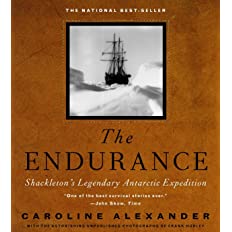 The Endurance by Caroline Alexander recounts the incredible experience of Ernest Shackleton and the crew of the Endurance on their expedition to Antarctica in 1914. Arriving in Antarctica, the ship became stuck in ice and eventually crushed; the crew abandoned the Endurance and engaged in an unparalleled struggle to survive and return to safety. The last of the 29 member crew were rescued in August 1916 – two years after the start of their ‘adventure’; a saved treasure trove of original unwieldy glass plate photos grimly testifies to their ordeal.
The Endurance by Caroline Alexander recounts the incredible experience of Ernest Shackleton and the crew of the Endurance on their expedition to Antarctica in 1914. Arriving in Antarctica, the ship became stuck in ice and eventually crushed; the crew abandoned the Endurance and engaged in an unparalleled struggle to survive and return to safety. The last of the 29 member crew were rescued in August 1916 – two years after the start of their ‘adventure’; a saved treasure trove of original unwieldy glass plate photos grimly testifies to their ordeal.  Adventures such as these are not reserved for men alone. Isak Dinesen,
Adventures such as these are not reserved for men alone. Isak Dinesen,  Two memories popped into my head as I stared out my window. I went on a Scottish Highland walk with Kristen a few years back. not surprisingly, we had a particularly Scottish highland day; rain, drizzle, mist and mud had soured my demeanour and curdled my enjoyment. I was not happy.
Two memories popped into my head as I stared out my window. I went on a Scottish Highland walk with Kristen a few years back. not surprisingly, we had a particularly Scottish highland day; rain, drizzle, mist and mud had soured my demeanour and curdled my enjoyment. I was not happy. On my latest pilgrimage, Blair and I were climbing the Great Saint Bernard Pass, a hard slog over the Alps and into Italy that I was not enjoying. A vague hope hovered in the air, Blair had promised a surprise when we reached the summit. Nearing the pass, I collapsed, a rest before the final 100 metres of push. We sat on a rock, the sun broke and Blair pulled two freeze-dried, astronaut-certified ice cream bars out of the bottom of his bag to celebrate our success. he’d thought of this weeks ago, bought them knowing they might be needed and offered them up to celebrate our achievement. My bad attitude disappeared, my joy emerged like the sun, I came to life.
On my latest pilgrimage, Blair and I were climbing the Great Saint Bernard Pass, a hard slog over the Alps and into Italy that I was not enjoying. A vague hope hovered in the air, Blair had promised a surprise when we reached the summit. Nearing the pass, I collapsed, a rest before the final 100 metres of push. We sat on a rock, the sun broke and Blair pulled two freeze-dried, astronaut-certified ice cream bars out of the bottom of his bag to celebrate our success. he’d thought of this weeks ago, bought them knowing they might be needed and offered them up to celebrate our achievement. My bad attitude disappeared, my joy emerged like the sun, I came to life. It occurred to me that I have been looking through the wrong end of life’s telescope. Life wasn’t shrinking, it was, if I let it, expanding. Walking slower meant more time for observation and reflection. Walking in the company of others allowed sharing, an intimacy that seems more valuable these days. Jumping in puddles can be a metaphorical talisman, if I allow it to fly free from the sad wet blanket I’ve thrown over it.
It occurred to me that I have been looking through the wrong end of life’s telescope. Life wasn’t shrinking, it was, if I let it, expanding. Walking slower meant more time for observation and reflection. Walking in the company of others allowed sharing, an intimacy that seems more valuable these days. Jumping in puddles can be a metaphorical talisman, if I allow it to fly free from the sad wet blanket I’ve thrown over it.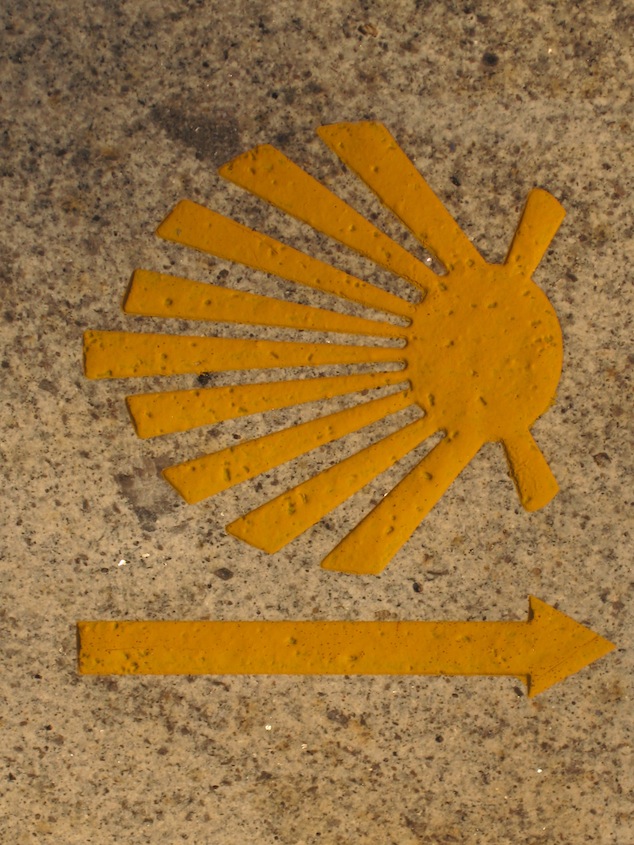 I have been home for a while and reflecting on my recent trip, the end of a ten year/5000 km series of four pilgrimages. I’m asked, and I ask myself, what did I get out of it? It’s not like I have, for a decade, carried an expectation of some grand epiphany or some other-worldly instant conversion like Saul/Paul on the road to Damascus. Yet something should have happened after all those miles, all those days alone, all that time away from the worldly distractions; something worth mentioning. Something kept me at it. The good news is that there has been transformation – not fireworks in the sky – but slow, gradual, meaningful and hopefully permanent transformation of the way I live my life.
I have been home for a while and reflecting on my recent trip, the end of a ten year/5000 km series of four pilgrimages. I’m asked, and I ask myself, what did I get out of it? It’s not like I have, for a decade, carried an expectation of some grand epiphany or some other-worldly instant conversion like Saul/Paul on the road to Damascus. Yet something should have happened after all those miles, all those days alone, all that time away from the worldly distractions; something worth mentioning. Something kept me at it. The good news is that there has been transformation – not fireworks in the sky – but slow, gradual, meaningful and hopefully permanent transformation of the way I live my life.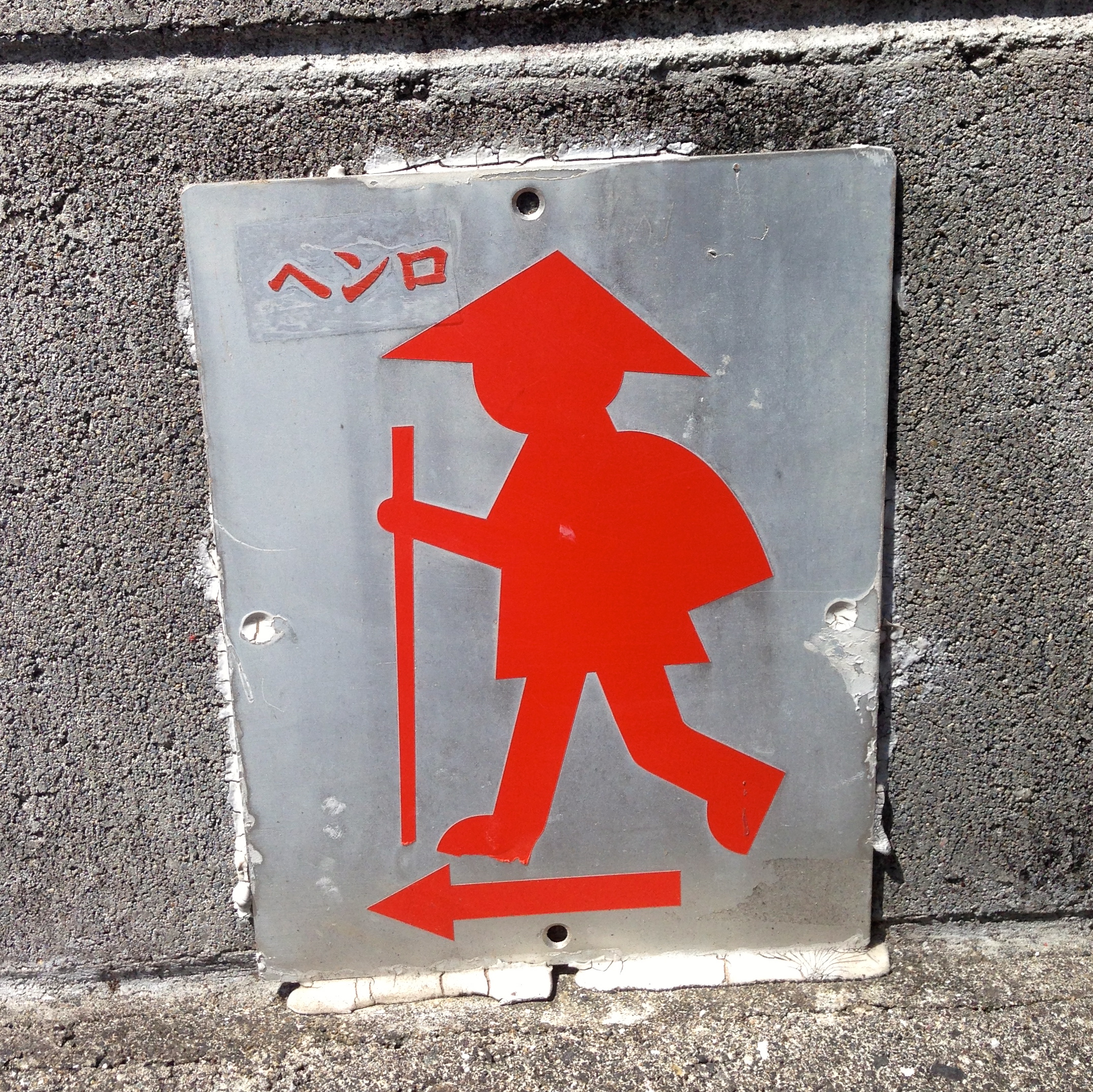 As for Catholicism, my personal experiences with organized Christian traditions and my jaded view of the impact of Christianity on people throughout history has made rethinking my beliefs a truly uphill battle, Sysiphus would have had an easier task.
As for Catholicism, my personal experiences with organized Christian traditions and my jaded view of the impact of Christianity on people throughout history has made rethinking my beliefs a truly uphill battle, Sysiphus would have had an easier task.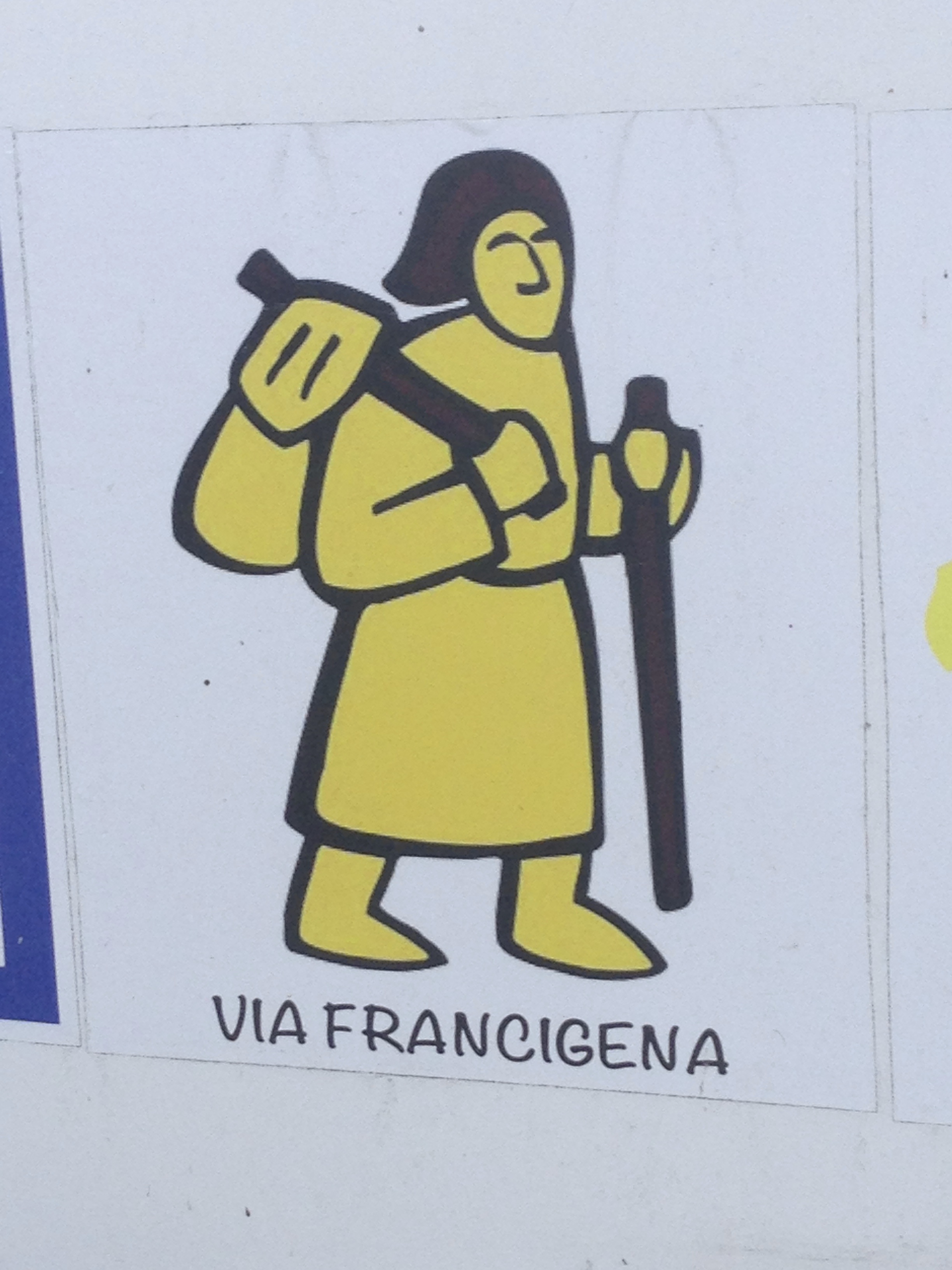 There is a long tradition of serious philosophers rhapsodizing about the impact walking has had on their thoughts about the central question of philosophic inquiry. How do we live the good life? Walking seems conducive to thinking big thoughts. Philosophers since the Ancient Greeks have given considerable time and thought on how to live the good life by thinking while walking; the process seems to have failed me, I don’t feel much wiser about how to live the good life. As one Saturday Night Live actor said, “Deep down, I’m quite shallow.” – maybe that fits, or I can’t think deeply and walk at the same time.
There is a long tradition of serious philosophers rhapsodizing about the impact walking has had on their thoughts about the central question of philosophic inquiry. How do we live the good life? Walking seems conducive to thinking big thoughts. Philosophers since the Ancient Greeks have given considerable time and thought on how to live the good life by thinking while walking; the process seems to have failed me, I don’t feel much wiser about how to live the good life. As one Saturday Night Live actor said, “Deep down, I’m quite shallow.” – maybe that fits, or I can’t think deeply and walk at the same time.
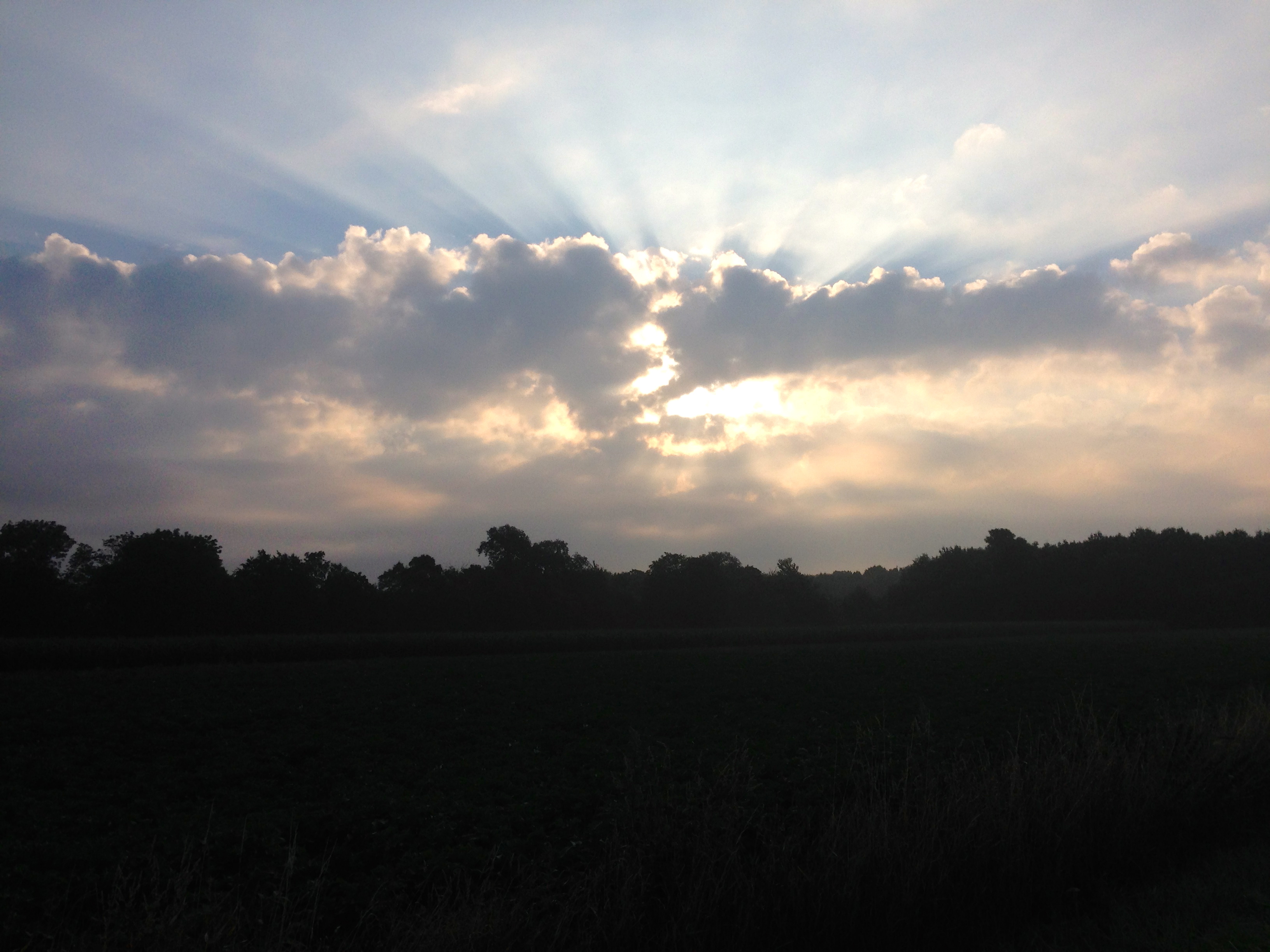 But there is also agency. I can do something about it. I have a backpack cover to protect my possessions, they’re all I have. I have a cheap, lightweight raincoat that I can put on if it rains. My trusty walking fedora will keep the rain off my face and my glasses. I can do things to manage. That is agency.
But there is also agency. I can do something about it. I have a backpack cover to protect my possessions, they’re all I have. I have a cheap, lightweight raincoat that I can put on if it rains. My trusty walking fedora will keep the rain off my face and my glasses. I can do things to manage. That is agency.
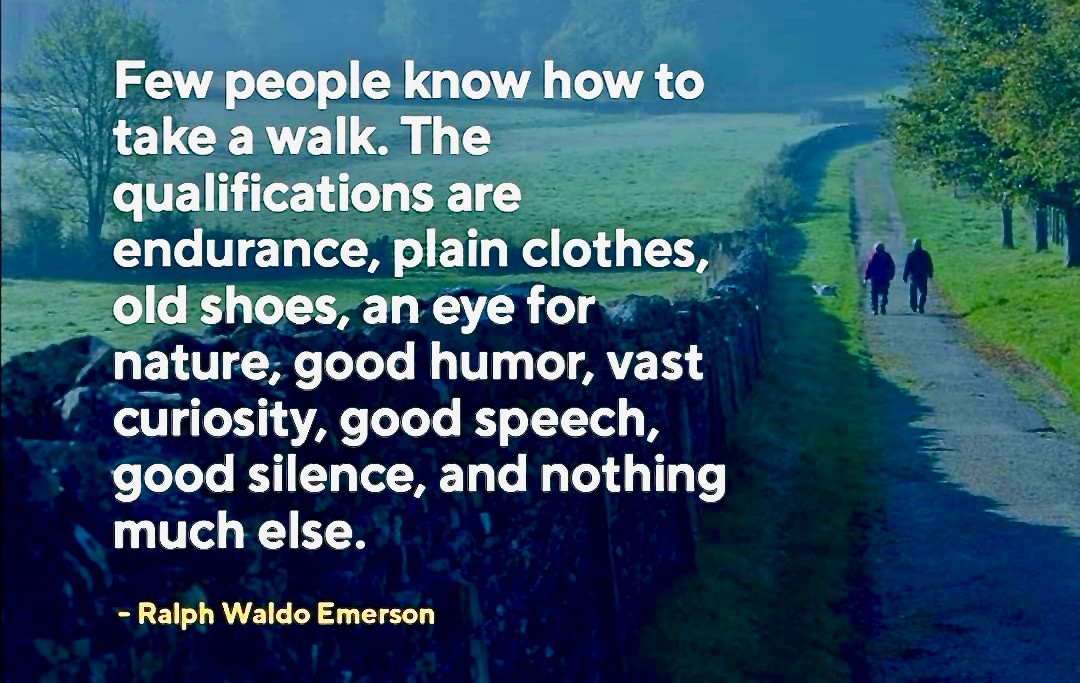

 Here’s a detail that illustrates. It’s the Easter long weekend. In Italy, it’s the big one. Everyone is on the move; places are closed. My much fantasized feast of fabulous Italian meals is delayed, it’s pizza joints staffed by kids who drew the short straw and had to work the Easter shift. Easter Monday was so bad that dinner consisted of a bag of chips and a coke zero from a sports bar. But, a bad Italian pizza gets more stars than most I’ve had in Vancouver.
Here’s a detail that illustrates. It’s the Easter long weekend. In Italy, it’s the big one. Everyone is on the move; places are closed. My much fantasized feast of fabulous Italian meals is delayed, it’s pizza joints staffed by kids who drew the short straw and had to work the Easter shift. Easter Monday was so bad that dinner consisted of a bag of chips and a coke zero from a sports bar. But, a bad Italian pizza gets more stars than most I’ve had in Vancouver.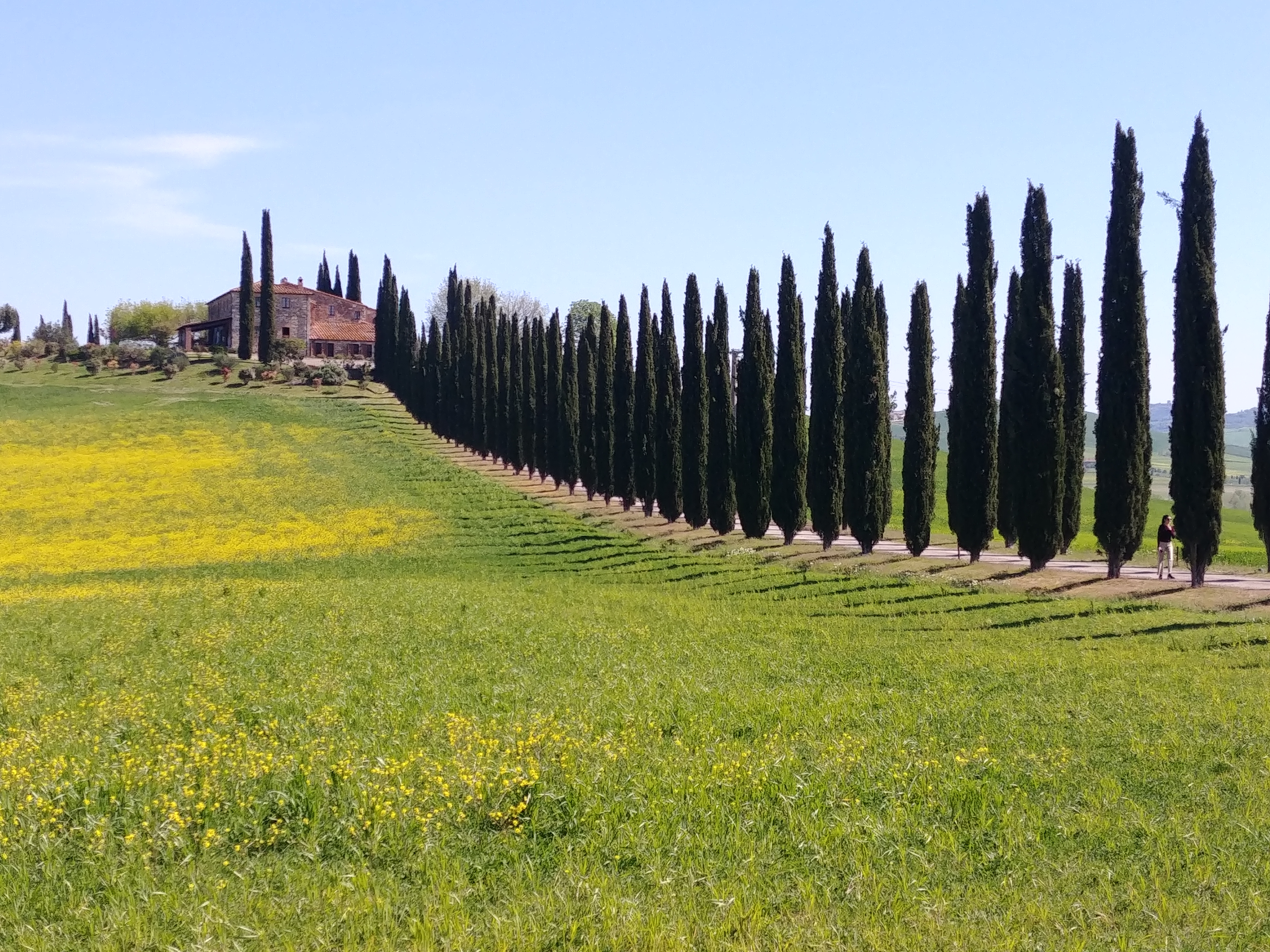
 I’ve managed to hit spring flowering season. My favorites – Irises – show off in more delightful variations of purple, white, yellow and blue than I have witnessed, perfect contrast to the green-spring palette. Grape vines are starting to sprout buds, the eternal promise of a bountiful harvest of grapes in the autumn. Olive trees abound, gnarly survivors showing their tenacity and age by their mis-shapened trunks. Winter wheat is more abundant than I expected.
I’ve managed to hit spring flowering season. My favorites – Irises – show off in more delightful variations of purple, white, yellow and blue than I have witnessed, perfect contrast to the green-spring palette. Grape vines are starting to sprout buds, the eternal promise of a bountiful harvest of grapes in the autumn. Olive trees abound, gnarly survivors showing their tenacity and age by their mis-shapened trunks. Winter wheat is more abundant than I expected.  As I follow the VF path, my stops usually take me to places of significance. Many such as Lucca, San Gimignano, Monteriggioni, Siena, and San Quirico d’Orcia owe their existence to the VF as important stops along the route. The VF became a source of commercial and artistic cross fertilization – pilgrims and others carried more than their packs with them and shared more than their food over dinner meals.
As I follow the VF path, my stops usually take me to places of significance. Many such as Lucca, San Gimignano, Monteriggioni, Siena, and San Quirico d’Orcia owe their existence to the VF as important stops along the route. The VF became a source of commercial and artistic cross fertilization – pilgrims and others carried more than their packs with them and shared more than their food over dinner meals. 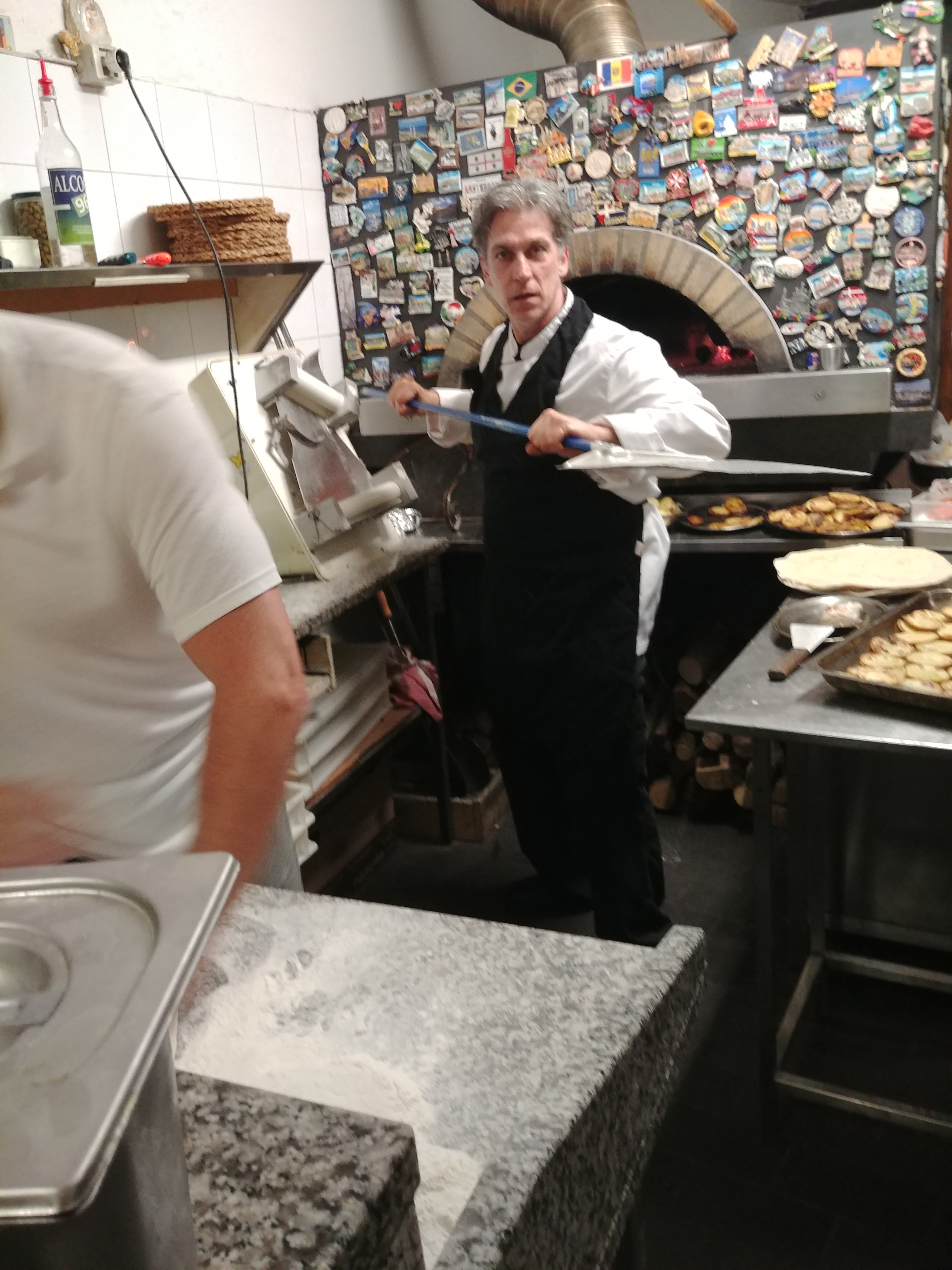 Unfortunately, the rest of the day is cold and rainy, I’m holed up in cold drafty hotel rooms, with no heat; I’m given an extra blanket for comfort if not survival. Yet even that brings an adventure. I arrive just before rain in Viterbo, call the hotel and Paulo (I never knew his real name) comes and gets me settled. I always ask for a restaurant recommendation, serendipitously, he owns a place a few blocks away. I clean up and wander over. Paulo is the chef, the Chef!!!; he greets me like an old friend. I leave everything up to him and have the best lunch and dinner of the journey. For an afternoon, I felt at home, amongst friends – precious comfort for a man on the road.
Unfortunately, the rest of the day is cold and rainy, I’m holed up in cold drafty hotel rooms, with no heat; I’m given an extra blanket for comfort if not survival. Yet even that brings an adventure. I arrive just before rain in Viterbo, call the hotel and Paulo (I never knew his real name) comes and gets me settled. I always ask for a restaurant recommendation, serendipitously, he owns a place a few blocks away. I clean up and wander over. Paulo is the chef, the Chef!!!; he greets me like an old friend. I leave everything up to him and have the best lunch and dinner of the journey. For an afternoon, I felt at home, amongst friends – precious comfort for a man on the road.




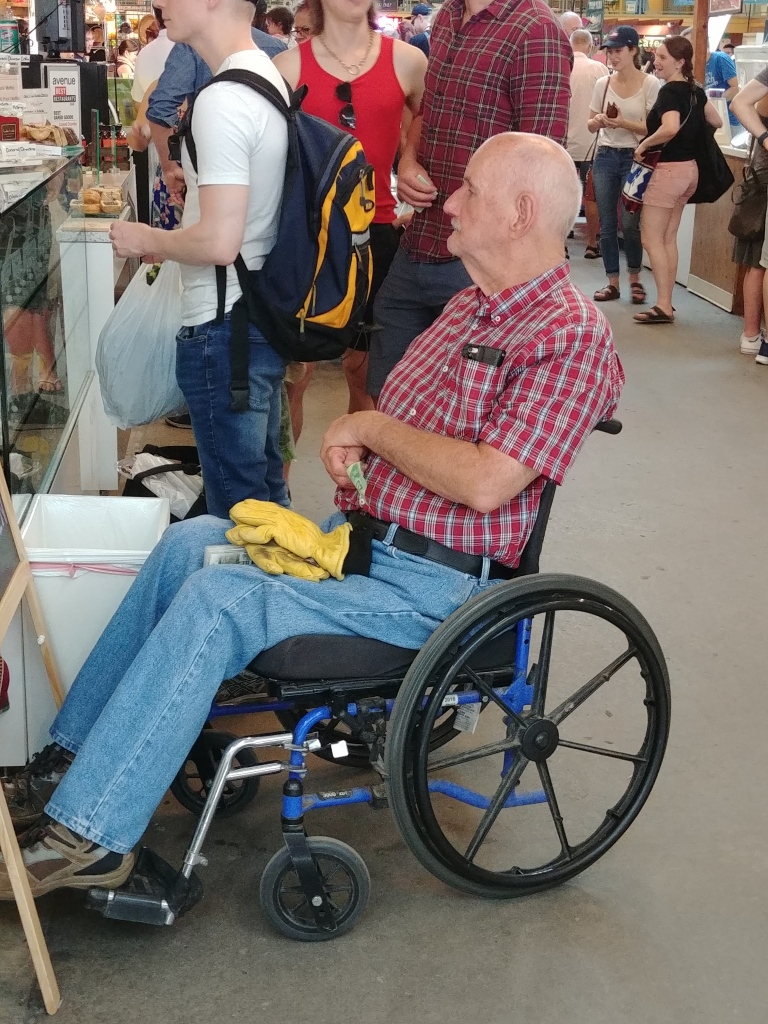














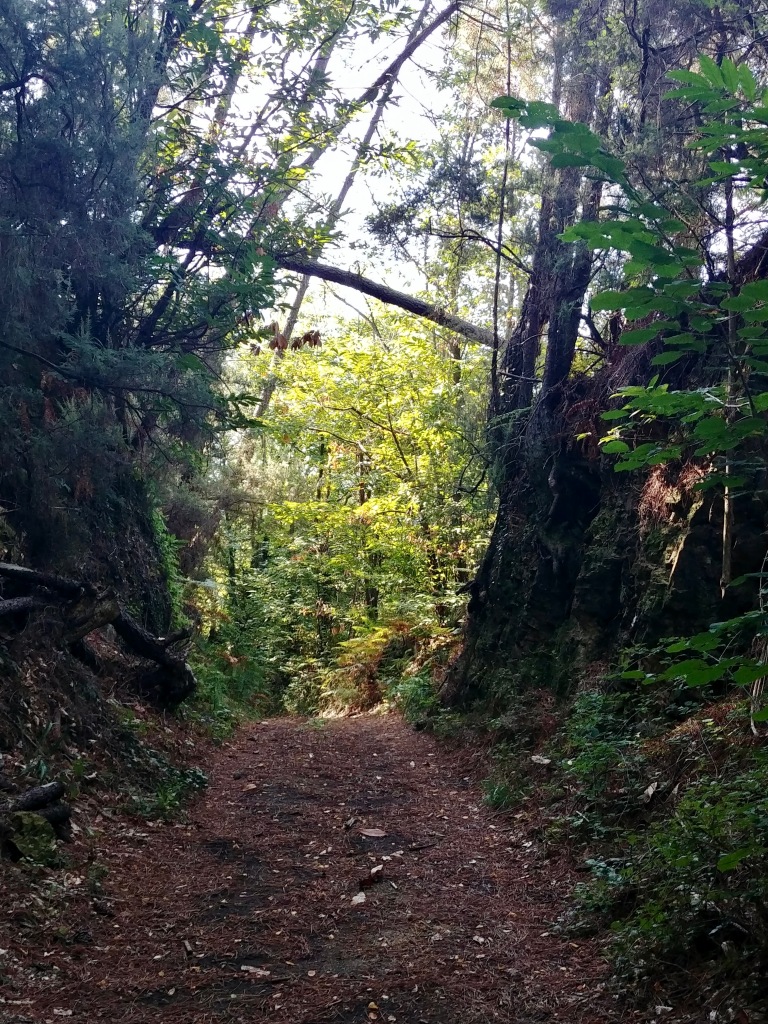










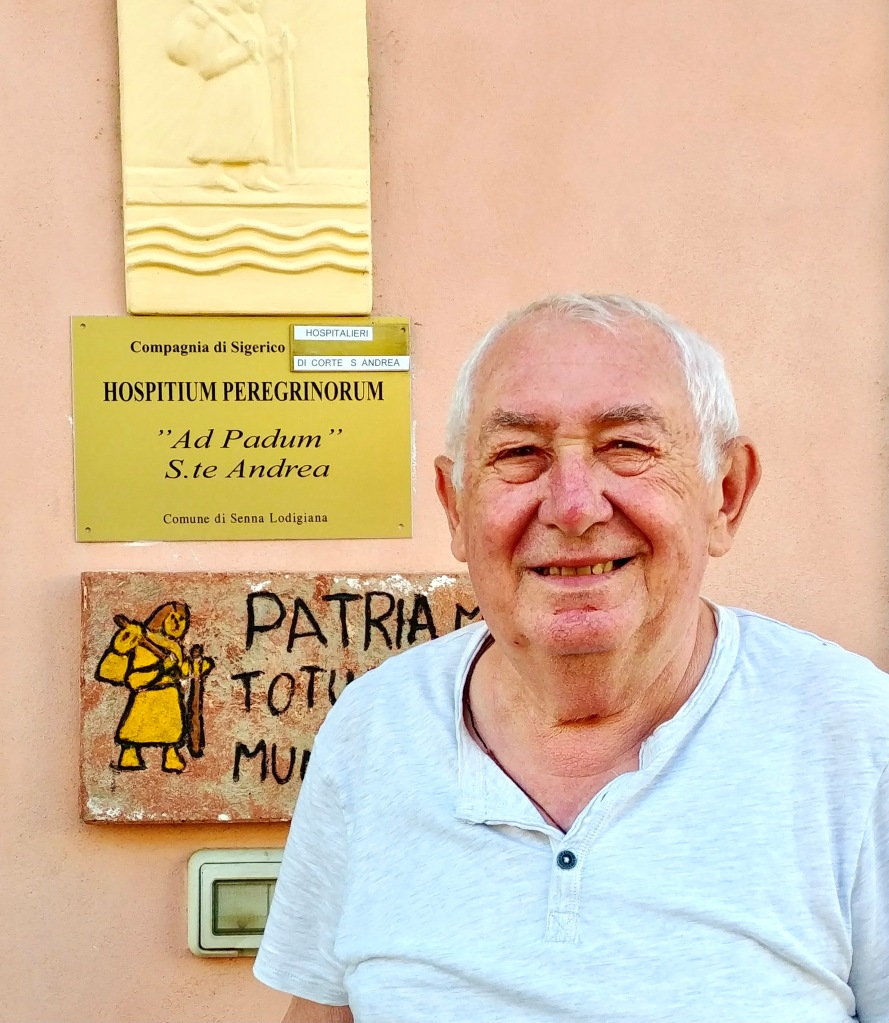

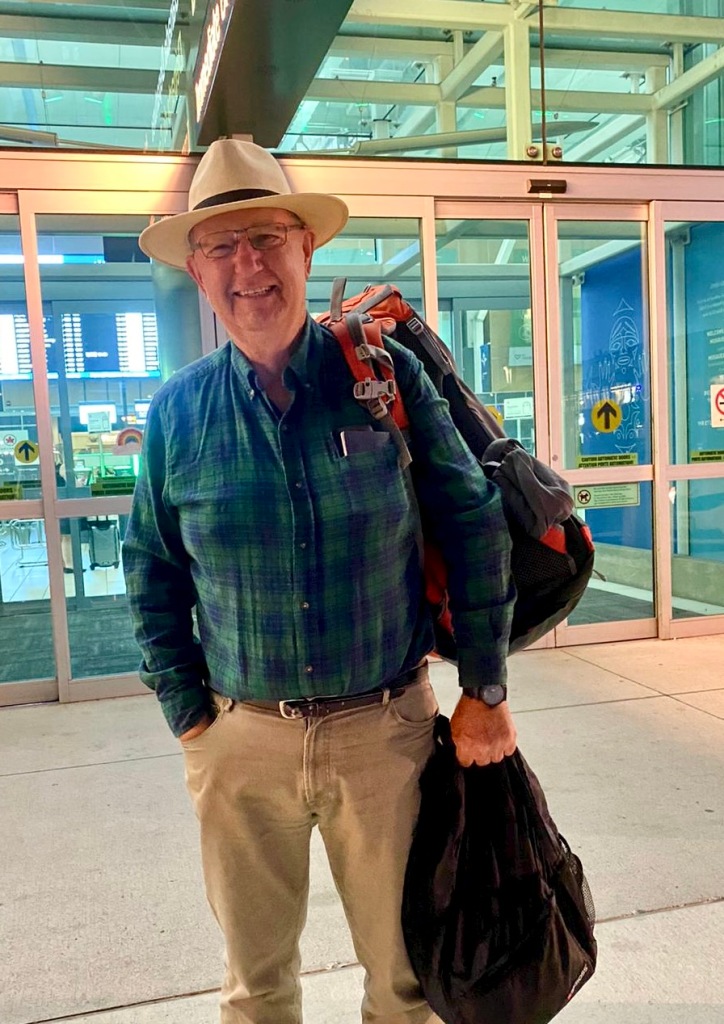





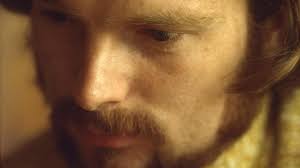




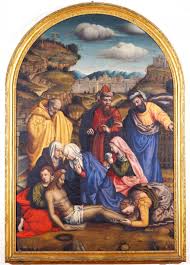















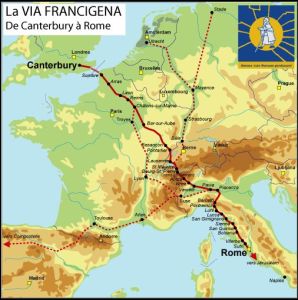 In 990, Sigeric, Abbot of St. Augustine’s Canterbury and the highest ranking member of the Anglo Saxon Catholic hierarchy in Britain, received word that Pope John XV wanted to elevate him to the role of Cardinal of the Roman Catholic Church.
In 990, Sigeric, Abbot of St. Augustine’s Canterbury and the highest ranking member of the Anglo Saxon Catholic hierarchy in Britain, received word that Pope John XV wanted to elevate him to the role of Cardinal of the Roman Catholic Church.
 What makes his pilgrimage notable is that one of his secretaries kept a careful log of his visits to 23 Roman churches over three days and recorded a daily log of his trip from Rome to Canterbury, a ‘guidebook’ in Latin of the stages and stops along the way.
What makes his pilgrimage notable is that one of his secretaries kept a careful log of his visits to 23 Roman churches over three days and recorded a daily log of his trip from Rome to Canterbury, a ‘guidebook’ in Latin of the stages and stops along the way.  There is nothing like walking a route traveled long ago to get some sense of what Sigeric experienced. While it was fraught with challenges, the route had been traveled for five or six centuries, Roman roads existed and continued to prove the remarkable and enduring talent of Roman engineering (we actually walked for part of a day on an old Roman road – straight as an arrow and still solid and passed an ancient Roman waystation that was part of a major Swiss archeological site).
There is nothing like walking a route traveled long ago to get some sense of what Sigeric experienced. While it was fraught with challenges, the route had been traveled for five or six centuries, Roman roads existed and continued to prove the remarkable and enduring talent of Roman engineering (we actually walked for part of a day on an old Roman road – straight as an arrow and still solid and passed an ancient Roman waystation that was part of a major Swiss archeological site).  In addition, monasteries, local and church sponsored charitable ‘hospitals’ purpose-built to serve pilgrims on their journey had been established that provided some rudimentary level of food and lodging along the way. (we managed to stay at a much refurbished hostel – now a Michelin starred destination restaurant/hotel – that sets its origins back to the 13th century)
In addition, monasteries, local and church sponsored charitable ‘hospitals’ purpose-built to serve pilgrims on their journey had been established that provided some rudimentary level of food and lodging along the way. (we managed to stay at a much refurbished hostel – now a Michelin starred destination restaurant/hotel – that sets its origins back to the 13th century)  The ancient Roman ruins were that – ruins. Major sites had fallen into disrepair, their stones cannibalized for church building, aqueducts had failed from lack of maintenance, the baths were dry and used more for itinerant housing, already less luxurious than in Rome’s halcyon days; even the Colosseum had become a large housing complex, filled with squatters. One of the few remaining sources of revenue seemed to be the thriving commerce of pilgrimage.
The ancient Roman ruins were that – ruins. Major sites had fallen into disrepair, their stones cannibalized for church building, aqueducts had failed from lack of maintenance, the baths were dry and used more for itinerant housing, already less luxurious than in Rome’s halcyon days; even the Colosseum had become a large housing complex, filled with squatters. One of the few remaining sources of revenue seemed to be the thriving commerce of pilgrimage. In an amazing feat of investigative academic research, there is almost universal consensus on the 23 churches noted in the diary of Sigeric’s visit to Rome, not a small task given the age of the document, the many possible interpretations that might have been given to some obvious mis-spellings and the destruction and sacking of Rome and its churches over 1000 years. Virginia Ortenberg, a British historian, has even reconstructed a map of Rome at the time marking the churches visited. She has also managed to provide some valuable descriptions of the state of the churches at the time and major artwork, architectural features, tombs and reliquary within the church.
In an amazing feat of investigative academic research, there is almost universal consensus on the 23 churches noted in the diary of Sigeric’s visit to Rome, not a small task given the age of the document, the many possible interpretations that might have been given to some obvious mis-spellings and the destruction and sacking of Rome and its churches over 1000 years. Virginia Ortenberg, a British historian, has even reconstructed a map of Rome at the time marking the churches visited. She has also managed to provide some valuable descriptions of the state of the churches at the time and major artwork, architectural features, tombs and reliquary within the church. The diary is a small document; it immediately begins to record the return journey to Canterbury. The places named on the return journey are more open to debate and interpretation, Ortenberg has attempted to chart the pilgrimage home on a map. As noted, this one pilgrimage by Sigeric in 990 AD and the few pages of diary entries chronicling the stops on the return trip to Canterbury has become the wellspring of the Via Francigena, a route that has guided untold numbers of pilgrims to Rome for 1000 years.
The diary is a small document; it immediately begins to record the return journey to Canterbury. The places named on the return journey are more open to debate and interpretation, Ortenberg has attempted to chart the pilgrimage home on a map. As noted, this one pilgrimage by Sigeric in 990 AD and the few pages of diary entries chronicling the stops on the return trip to Canterbury has become the wellspring of the Via Francigena, a route that has guided untold numbers of pilgrims to Rome for 1000 years. 



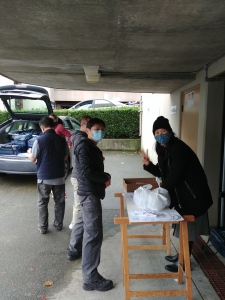
 An hour or so later, I’ve managed to drop off all my meals, although once, I had one meal left over and had to figure out who I’d missed – a panic attack that I never wanted to repeat.
An hour or so later, I’ve managed to drop off all my meals, although once, I had one meal left over and had to figure out who I’d missed – a panic attack that I never wanted to repeat. 
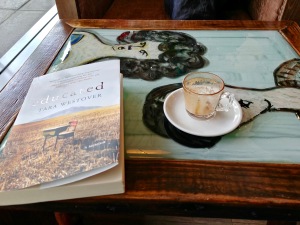 In the past few days, I experienced two events worth marking in time; I had my first haircut in over two months (sorry, photographic evidence will not be forthcoming) and I had my first sit-down coffee, a double espresso machiatto, in a proper glass cup in a new local coffee shop, one that will probably become my new home on Denman Street.
In the past few days, I experienced two events worth marking in time; I had my first haircut in over two months (sorry, photographic evidence will not be forthcoming) and I had my first sit-down coffee, a double espresso machiatto, in a proper glass cup in a new local coffee shop, one that will probably become my new home on Denman Street.  To be honest, even though we are only through phase one of what may be a long process, it hasn’t been that tough. So Far…
To be honest, even though we are only through phase one of what may be a long process, it hasn’t been that tough. So Far… I saw birds and beasts, a coyote, a woodpecker, a river otter, eagles, rabbits – all enjoying the quiet desolation resulting from our retreat from their habitat. Slowing down and mindfully observing has its benefits.
I saw birds and beasts, a coyote, a woodpecker, a river otter, eagles, rabbits – all enjoying the quiet desolation resulting from our retreat from their habitat. Slowing down and mindfully observing has its benefits.
 I worked on jigsaw puzzles when I got to restless, unable to sit still anymore. It kept me from the Television and the train wreck south of the border that was so mesmerizing yet so demoralizing. Putting one piece in place gave me a sense of accomplishment, instant gratification and power in a new world where I had little of any of those feelings.
I worked on jigsaw puzzles when I got to restless, unable to sit still anymore. It kept me from the Television and the train wreck south of the border that was so mesmerizing yet so demoralizing. Putting one piece in place gave me a sense of accomplishment, instant gratification and power in a new world where I had little of any of those feelings.
 Likewise for many friends spread outside my immediate neighbourhood, not forgotten and certainly not lost for anything more than the temporariness of the current construct.
Likewise for many friends spread outside my immediate neighbourhood, not forgotten and certainly not lost for anything more than the temporariness of the current construct. 

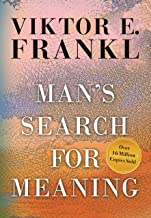
 Epictetus was a Roman Stoic philosopher whose teachings were preserved in two tracts called the Discourses and the Enchridion. It’s hard to miss the point:“…the gods have given us the most efficacious gift: the ability to make good use of our impressions.” …The knowledge of what is mine and what is not mine, what I can and cannot do. I must die. But must I die bawling? I must be put in chains – but moaning and groaning too? I must be exiled, but is there anything to keep me from going with a smile, calm and self-composed?” Discourses I.1
Epictetus was a Roman Stoic philosopher whose teachings were preserved in two tracts called the Discourses and the Enchridion. It’s hard to miss the point:“…the gods have given us the most efficacious gift: the ability to make good use of our impressions.” …The knowledge of what is mine and what is not mine, what I can and cannot do. I must die. But must I die bawling? I must be put in chains – but moaning and groaning too? I must be exiled, but is there anything to keep me from going with a smile, calm and self-composed?” Discourses I.1

 Seneca is one of the three most famous Roman Stoics. His book, Letters from a Stoic, is required reading for anyone interested in this philosophic tradition. Seneca emphasized the capricious nature of Fortune; all that Fortune provides can be snatched away in an instant;
Seneca is one of the three most famous Roman Stoics. His book, Letters from a Stoic, is required reading for anyone interested in this philosophic tradition. Seneca emphasized the capricious nature of Fortune; all that Fortune provides can be snatched away in an instant;
 I also avoid negative reinforcement, especially the aging male coffee clatch. They’re called ROMEOs – really old men eating out. I see them everywhere, befuddled anxious-looking men who gather at the corner cafe to read the newspapers together, express their shock and amazement at the current state of affairs in our city/province/nation/world, inevitably shining up the good-old-days, complete with our biases and privileges. It’s backward looking and hermetically sealed, dusty and dead, self fulfilling and incapable of admitting new experiences or insights.
I also avoid negative reinforcement, especially the aging male coffee clatch. They’re called ROMEOs – really old men eating out. I see them everywhere, befuddled anxious-looking men who gather at the corner cafe to read the newspapers together, express their shock and amazement at the current state of affairs in our city/province/nation/world, inevitably shining up the good-old-days, complete with our biases and privileges. It’s backward looking and hermetically sealed, dusty and dead, self fulfilling and incapable of admitting new experiences or insights. GLS is my latest antidote – my wonder drug – for staying open to the new; meeting head-on the uncertainty, change and unfamiliarity that comes with shaking up my deeply-held beliefs and challenging my preconceived notions.
GLS is my latest antidote – my wonder drug – for staying open to the new; meeting head-on the uncertainty, change and unfamiliarity that comes with shaking up my deeply-held beliefs and challenging my preconceived notions.  The other implicit factor in the rheostat model I have constructed is that reason controls passion.
The other implicit factor in the rheostat model I have constructed is that reason controls passion. The Autobiography of Red gripped me and discombobulated me in ways that I am still sorting through. It is complicated, inflammatory and rich with ambiguity, much of which I feel I’m missing. I need more – of something, I’m not sure what. Moving my rheostat isn’t helping much.
The Autobiography of Red gripped me and discombobulated me in ways that I am still sorting through. It is complicated, inflammatory and rich with ambiguity, much of which I feel I’m missing. I need more – of something, I’m not sure what. Moving my rheostat isn’t helping much. I’d written of my first – Aha – my teachable moment of experiencing Sappho rather than understanding her. My initial attempt to experience her poetry was to read everything in our assigned textbook, Stung with Love by Aaron Poochigian, before actually reading Sappho’s words. I was dialled in at about 90% reason on my reason/passion rheostat. I would find context and understanding through Poochigian before I read Sappho’s poems.
I’d written of my first – Aha – my teachable moment of experiencing Sappho rather than understanding her. My initial attempt to experience her poetry was to read everything in our assigned textbook, Stung with Love by Aaron Poochigian, before actually reading Sappho’s words. I was dialled in at about 90% reason on my reason/passion rheostat. I would find context and understanding through Poochigian before I read Sappho’s poems.  In contrast to Poochigian’s 50 dense pages of notes and explanatory miscellanea, Anne Carson’s introduction notes for If Not Winter are all of 5 pages long.
In contrast to Poochigian’s 50 dense pages of notes and explanatory miscellanea, Anne Carson’s introduction notes for If Not Winter are all of 5 pages long.  Eros the Bittersweet, one of Carson’s first books, published in 1986 reflects extensively on the elusive attraction of…well…attraction – Eros. It is no ordinary book; the Modern Library selected it to be one of the 100 best non-fiction books of all time.
Eros the Bittersweet, one of Carson’s first books, published in 1986 reflects extensively on the elusive attraction of…well…attraction – Eros. It is no ordinary book; the Modern Library selected it to be one of the 100 best non-fiction books of all time. Carson also brings her intellectual insight to bear on Plato’s discourse on Love and the challenges of the written word. She examines Phaedrus, Plato’s examination of love and his critique of writing.
Carson also brings her intellectual insight to bear on Plato’s discourse on Love and the challenges of the written word. She examines Phaedrus, Plato’s examination of love and his critique of writing.  My thoughts after each class are unpredictable, depending on whether I emerge confused or enlightened from the evening’s discussion.
My thoughts after each class are unpredictable, depending on whether I emerge confused or enlightened from the evening’s discussion. I also know that I resist; I resist new, I resist change and I resist that which makes me uncomfortable.
I also know that I resist; I resist new, I resist change and I resist that which makes me uncomfortable.  On September 4, I walked into the downtown campus of Simon Fraser University as a student, a real bona fide student. I had my own student card, I had a student account and a password that helped me navigate the labyrinth of rules and regulations guarding entrance to this august body.
On September 4, I walked into the downtown campus of Simon Fraser University as a student, a real bona fide student. I had my own student card, I had a student account and a password that helped me navigate the labyrinth of rules and regulations guarding entrance to this august body.  But first, a recap. Last year, I managed to stow away on a field trip organized by the Graduate Liberal Studies program at SFU. We spent three weeks in southern Spain, half doing it as a course for credit in the program, half as spouses of students, alumnae, itinerant vagabonds and other riff-raff. Truth be told, I was the only riff-raff.
But first, a recap. Last year, I managed to stow away on a field trip organized by the Graduate Liberal Studies program at SFU. We spent three weeks in southern Spain, half doing it as a course for credit in the program, half as spouses of students, alumnae, itinerant vagabonds and other riff-raff. Truth be told, I was the only riff-raff.  The course was a study of the Islamic influence on Spanish culture; the Moors as they were called, ruled most of Spain from the 7th to the 14th century, in an uneasy relationship with the emerging Christian population and a significant Jewish community.
The course was a study of the Islamic influence on Spanish culture; the Moors as they were called, ruled most of Spain from the 7th to the 14th century, in an uneasy relationship with the emerging Christian population and a significant Jewish community. My week starts on Wednesday. I walk to the downtown campus for a 5pm dinner with my 15 classmates and our professor, Dr. Colby, for the first semester. The dinner is integral to the process, a freewheeling discussion o
My week starts on Wednesday. I walk to the downtown campus for a 5pm dinner with my 15 classmates and our professor, Dr. Colby, for the first semester. The dinner is integral to the process, a freewheeling discussion o At around 9:30 pm, I’m spun out into the street and off into the night. I wander home, dodging the nocturnals, most important of which are the skunks out foraging. I have to be careful because I’m in a bit of a state; the evening’s discussion can leave me gasping for air and feeling a little light-headed and therefore distracted, I need to remember to watch for the skunks. They do not like surprises!
At around 9:30 pm, I’m spun out into the street and off into the night. I wander home, dodging the nocturnals, most important of which are the skunks out foraging. I have to be careful because I’m in a bit of a state; the evening’s discussion can leave me gasping for air and feeling a little light-headed and therefore distracted, I need to remember to watch for the skunks. They do not like surprises! The requirements for the degree start with the two mandatory courses; Reason and Passion – I & II. The curriculum has been built, refined and tweaked over some twenty nine years by Dr. Stephen Duguid, the first Director; his stamp is still evident.
The requirements for the degree start with the two mandatory courses; Reason and Passion – I & II. The curriculum has been built, refined and tweaked over some twenty nine years by Dr. Stephen Duguid, the first Director; his stamp is still evident.  This semester our reading list ranges from Sappho, an enthralling Greek poet (her powerful words touch crusty old men across 2500 years of time), Plato (who knew he wrote important works other than the Republic?), Anne Carson (a Canadian, a McArthur fellow and author of a book designated as one of the 100 most important pieces of non-fiction of all time!), Virginia Woolf (I regret not having discovered her earlier in life, who knows how things might have been changed?) and Tompson Highway (another distinguished but often overlooked Canadian).
This semester our reading list ranges from Sappho, an enthralling Greek poet (her powerful words touch crusty old men across 2500 years of time), Plato (who knew he wrote important works other than the Republic?), Anne Carson (a Canadian, a McArthur fellow and author of a book designated as one of the 100 most important pieces of non-fiction of all time!), Virginia Woolf (I regret not having discovered her earlier in life, who knows how things might have been changed?) and Tompson Highway (another distinguished but often overlooked Canadian). 
 There is one other aspect to this decision to become a student.
There is one other aspect to this decision to become a student. Now, they’re not the big flashy high top ones that scared me when I first saw them, they were too much. But I have the iconic black lace-ups and I wear them to school every Wednesday night.
Now, they’re not the big flashy high top ones that scared me when I first saw them, they were too much. But I have the iconic black lace-ups and I wear them to school every Wednesday night.  Ten years ago, on June 29, 2009, I walked into Chef Patrice’s kitchen at Pacific Institute of Culinary Arts. I had just turned sixty and learning how to cook, really cook, seemed like a good idea; maybe a little late in the game but still full of possibility. Besides, it was my birthday present to myself.
Ten years ago, on June 29, 2009, I walked into Chef Patrice’s kitchen at Pacific Institute of Culinary Arts. I had just turned sixty and learning how to cook, really cook, seemed like a good idea; maybe a little late in the game but still full of possibility. Besides, it was my birthday present to myself. Chef Patrice, and later Chef Johannes, would become my kitchen gods; true chefs who had mastered the culinary skills, run successful restaurants, clawed their way to the top in a world where one bad review can destroy years of effort.
Chef Patrice, and later Chef Johannes, would become my kitchen gods; true chefs who had mastered the culinary skills, run successful restaurants, clawed their way to the top in a world where one bad review can destroy years of effort.  Our chef walked us through the basics of the French culinary tradition; knife skills, stocks and sauces, even a bit of baking. Our classroom was the kitchen; Chef demonstrated, we replicated – as best we could.
Our chef walked us through the basics of the French culinary tradition; knife skills, stocks and sauces, even a bit of baking. Our classroom was the kitchen; Chef demonstrated, we replicated – as best we could.  A surprising unintended consequence of my adventure was a new adventure; a book about my experience. I knew I would never work in the culinary industry so, when I left culinary skill, rather than find a job I pursued my second passion, writing.
A surprising unintended consequence of my adventure was a new adventure; a book about my experience. I knew I would never work in the culinary industry so, when I left culinary skill, rather than find a job I pursued my second passion, writing.
 Second, always buy the best and freshest ingredients you can afford. A marinara sauce consists of garlic, canned tomatoes, red pepper flakes and olive oil – each of those ingredients matters, even the canned tomatoes. For example, most marinara recipes call for genuine DOP San Marzano tomatoes from Italy. D
Second, always buy the best and freshest ingredients you can afford. A marinara sauce consists of garlic, canned tomatoes, red pepper flakes and olive oil – each of those ingredients matters, even the canned tomatoes. For example, most marinara recipes call for genuine DOP San Marzano tomatoes from Italy. D Third, always complete your prep -ALWAYS – before turning on the stove. The French term is mise en place, everything in it’s place. It reminds me to do all the gathering of ingredients, all the chopping and cutting, all the accessing of pots and pans, all the advance work possible before starting the process of cooking. Serving food at its best only works if I can concentrate on what’s going on in my saute pan without being distracted by the need to chop another ingredient that isn’t ready for the next stage yet.
Third, always complete your prep -ALWAYS – before turning on the stove. The French term is mise en place, everything in it’s place. It reminds me to do all the gathering of ingredients, all the chopping and cutting, all the accessing of pots and pans, all the advance work possible before starting the process of cooking. Serving food at its best only works if I can concentrate on what’s going on in my saute pan without being distracted by the need to chop another ingredient that isn’t ready for the next stage yet.
 at my table, food that I have prepared and served. Sharing food is an intimate event that is deeply embedded in our DNA.
at my table, food that I have prepared and served. Sharing food is an intimate event that is deeply embedded in our DNA. My six months at cooking school gave me the tools and the confidence to invite friends into my home, serve them food that I was proud of, and enjoy the warmth and intimacy of conversation and communion. That was the real benefit of slaving under the temporary tutelage of Chef Patrice and Chef Johannes. They opened the doors to a decade of bliss around my little table.
My six months at cooking school gave me the tools and the confidence to invite friends into my home, serve them food that I was proud of, and enjoy the warmth and intimacy of conversation and communion. That was the real benefit of slaving under the temporary tutelage of Chef Patrice and Chef Johannes. They opened the doors to a decade of bliss around my little table. 
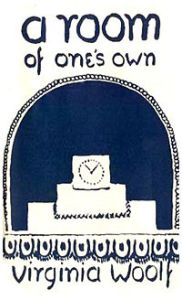 I came across a small book by Virginia Woolf, A Room of One’s Own, in a discount bin at Munro’s Books in Victoria last weekend.
I came across a small book by Virginia Woolf, A Room of One’s Own, in a discount bin at Munro’s Books in Victoria last weekend.
 It’s too long a story to describe in detail but, last spring, I managed to talk my way into a study tour of southern Spain run by a small program at Simon Fraser University, the Graduate Liberal Studies (GLS) Program. It involved a mix of students who were taking the course for credit, alumnae who were meeting up with old colleagues and a few strays like myself who had wandered in off the street.
It’s too long a story to describe in detail but, last spring, I managed to talk my way into a study tour of southern Spain run by a small program at Simon Fraser University, the Graduate Liberal Studies (GLS) Program. It involved a mix of students who were taking the course for credit, alumnae who were meeting up with old colleagues and a few strays like myself who had wandered in off the street.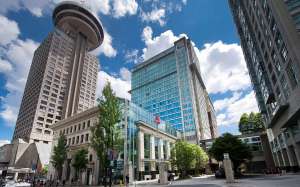 The program is run out of the downtown Harbour Centre campus, I can walk to classes. The place hums and has the feel of a downtown university. The first two mandatory courses are held one night a week; they consist of a dinner and a three hour session, a discussion led by the professor.
The program is run out of the downtown Harbour Centre campus, I can walk to classes. The place hums and has the feel of a downtown university. The first two mandatory courses are held one night a week; they consist of a dinner and a three hour session, a discussion led by the professor.
 Every time I awoke that first night, confused, drugged, tied to tubes and beeping/blinking instruments, prodded by nurses for vital signs, she was there, sitting calmly and quietly by my side exuding comfort and support. She was my guardian angel; a memory that will stay with me forever.
Every time I awoke that first night, confused, drugged, tied to tubes and beeping/blinking instruments, prodded by nurses for vital signs, she was there, sitting calmly and quietly by my side exuding comfort and support. She was my guardian angel; a memory that will stay with me forever. 
 The first part of my adventure went according to plan. A wedding in Whitstable, a village on the east coast of England in Kent, a short train ride from London. It was picture perfect framing for a joyful event.
The first part of my adventure went according to plan. A wedding in Whitstable, a village on the east coast of England in Kent, a short train ride from London. It was picture perfect framing for a joyful event.  We ended our shared time with a small dinner. The big event was a success, we could relax with our friends, bask in their joyous glow and gossip to our hearts’ content. We recognize that these sweet spots in our lives are fleeting, valuable and valued.
We ended our shared time with a small dinner. The big event was a success, we could relax with our friends, bask in their joyous glow and gossip to our hearts’ content. We recognize that these sweet spots in our lives are fleeting, valuable and valued. Rather than yelling and cursing across endless faux-drama, cooking soap operas, Ottolenghi has been revolutionizing the way we cook and enjoy food.
Rather than yelling and cursing across endless faux-drama, cooking soap operas, Ottolenghi has been revolutionizing the way we cook and enjoy food. 
 The Grand Budapest Hotel is one of my favorite movies. An all star cast, the crazy genius of Wes Anderson and a zany plot driven by superb writing, I’ve seen it many times.
The Grand Budapest Hotel is one of my favorite movies. An all star cast, the crazy genius of Wes Anderson and a zany plot driven by superb writing, I’ve seen it many times. 
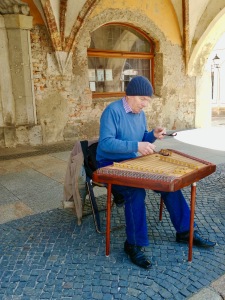 Saved from wartime destruction, Gorlitz is an architectural gem, churches, houses, streets that seem straight from a history book. It’s also a starting point for those who wish to walk the Camino de Santiago. The Polish route is only 3152 kms.
Saved from wartime destruction, Gorlitz is an architectural gem, churches, houses, streets that seem straight from a history book. It’s also a starting point for those who wish to walk the Camino de Santiago. The Polish route is only 3152 kms. There is a little museum in Dresden that shows the common day-to-day artifacts of that period. It reminds me that, amazing differences aside, people still lived their lives.
There is a little museum in Dresden that shows the common day-to-day artifacts of that period. It reminds me that, amazing differences aside, people still lived their lives.  There is a small museum outside the tourist zone that is haunting. The Dresden Panometer has created, by stitching together photos of the aftermath of the February 1945 firebombing of the city, a huge 360 degree panorama of Dresden after the firebombing. The visual stuns one into silence. It is an assault on the senses, a graphic reminder of the horror of war. It takes minutes to view and lasts a lifetime in the imagination.
There is a small museum outside the tourist zone that is haunting. The Dresden Panometer has created, by stitching together photos of the aftermath of the February 1945 firebombing of the city, a huge 360 degree panorama of Dresden after the firebombing. The visual stuns one into silence. It is an assault on the senses, a graphic reminder of the horror of war. It takes minutes to view and lasts a lifetime in the imagination.  The Elbe River flows through Dresden. it has been a commanding, geographic pivotal element of Germany since recorded history. European focused Germany lies west of the Elbe; the Germany east of the Elbe has followed a different course. Unconquered by Rome, it has been forever less European, more unruly, more Prussian, more Slavic, more influenced by Russia.
The Elbe River flows through Dresden. it has been a commanding, geographic pivotal element of Germany since recorded history. European focused Germany lies west of the Elbe; the Germany east of the Elbe has followed a different course. Unconquered by Rome, it has been forever less European, more unruly, more Prussian, more Slavic, more influenced by Russia.  To discover the existence of, and visit, all these off beat, quirky places it is important to consult locals, or the next best thing – Chris. He’s as local as I can find, speaks pretty good German, likes to poke around and enables my poking around by being my guide.
To discover the existence of, and visit, all these off beat, quirky places it is important to consult locals, or the next best thing – Chris. He’s as local as I can find, speaks pretty good German, likes to poke around and enables my poking around by being my guide.  It is important to venture outside my comfort zone on these serendipitous adventures, to take advantage of oddities. Our last oddity is a visit to the Opera; Semperoper in Dresden is worthy of a visit for its architecture and beauty alone. But we are blessed, a performance of Mozart’s The Magic Flute allows us the chance to see an opera in the theatre built for opera. Now, those who know me will understand that this does meet the out-of-my-comfort-zone test. It was delightful; made more so by being able to share it with my Dresden guides. I’m good for another five years.
It is important to venture outside my comfort zone on these serendipitous adventures, to take advantage of oddities. Our last oddity is a visit to the Opera; Semperoper in Dresden is worthy of a visit for its architecture and beauty alone. But we are blessed, a performance of Mozart’s The Magic Flute allows us the chance to see an opera in the theatre built for opera. Now, those who know me will understand that this does meet the out-of-my-comfort-zone test. It was delightful; made more so by being able to share it with my Dresden guides. I’m good for another five years.
 I drive to Calgary, drop the car at the airport and fly to Ottawa. Phase one is a visit with Blair. Blair has a well deserved Reading Week – he spends it reading the snow conditions at Lake Louise and visiting friends in Calgary.
I drive to Calgary, drop the car at the airport and fly to Ottawa. Phase one is a visit with Blair. Blair has a well deserved Reading Week – he spends it reading the snow conditions at Lake Louise and visiting friends in Calgary.  I spend the week visiting friends and taking care of his dog Austin.
I spend the week visiting friends and taking care of his dog Austin. I bundle up, we venture outside and brave the biting cold of an Ottawa day. The good part about our walks is that they leave us both pleasantly fatigued. We sleep the deep sleep of the just.
I bundle up, we venture outside and brave the biting cold of an Ottawa day. The good part about our walks is that they leave us both pleasantly fatigued. We sleep the deep sleep of the just. 
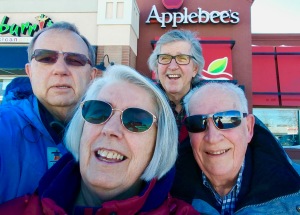
 In Red Deer, Blair’s nephew Russell takes us on a tour of RCMP headquarters, where he serves. We return to a sumptuous Korean dinner that SunJa, Russell’s wife had prepared. The evening’s entertainment is provided by their three delightful, energetic and talented children; Jaden, Leisha and Neven. Sometimes, traveling sweet spots appear when least expected; it is there on this night in the city of Red Deer.
In Red Deer, Blair’s nephew Russell takes us on a tour of RCMP headquarters, where he serves. We return to a sumptuous Korean dinner that SunJa, Russell’s wife had prepared. The evening’s entertainment is provided by their three delightful, energetic and talented children; Jaden, Leisha and Neven. Sometimes, traveling sweet spots appear when least expected; it is there on this night in the city of Red Deer.  My brother Marvin lives in Edmonton, no one understands why; but his roots are deep in the city. He raised his son Michael here, managed a small but vital child service agency, Chimo, and still now in his 70’s contributes to his city as a board member of the Boyle Street Education Centre –
My brother Marvin lives in Edmonton, no one understands why; but his roots are deep in the city. He raised his son Michael here, managed a small but vital child service agency, Chimo, and still now in his 70’s contributes to his city as a board member of the Boyle Street Education Centre –  Next day, a long drive through the mountains to Silver Star, a sweet little ski resort near Vernon.
Next day, a long drive through the mountains to Silver Star, a sweet little ski resort near Vernon. We return to Vancouver and another round of visits. A spirited discussion of current Ottawa shenanigans spice up dinners and lunches with friends near and dear.
We return to Vancouver and another round of visits. A spirited discussion of current Ottawa shenanigans spice up dinners and lunches with friends near and dear. 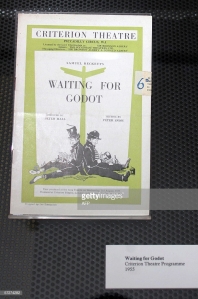
 I won’t bore you with my analysis of Beckett; I could not credibly pull it off. He did deserve his Nobel Prize even if he is bleak; a person so gifted that he had to write in French to slow down/dumb down his writing to be even hopefully incomprehensible.
I won’t bore you with my analysis of Beckett; I could not credibly pull it off. He did deserve his Nobel Prize even if he is bleak; a person so gifted that he had to write in French to slow down/dumb down his writing to be even hopefully incomprehensible.  I have found that fear is a powerful motivator for me; in my running days I had a fear based training program. Set an impossible goal, then use fear of failing to motivate the necessary training.
I have found that fear is a powerful motivator for me; in my running days I had a fear based training program. Set an impossible goal, then use fear of failing to motivate the necessary training. There’s another powerful motivator – the prize; if I complete a task, I get a prize. I dangle it like a carrot in front of me.
There’s another powerful motivator – the prize; if I complete a task, I get a prize. I dangle it like a carrot in front of me. 
 Chris faced daily life in Basel, managing a host of tasks in a different language, a different culture; untold numbers of ways to make things complicated and add multiple twists and turns to even the simplest task.
Chris faced daily life in Basel, managing a host of tasks in a different language, a different culture; untold numbers of ways to make things complicated and add multiple twists and turns to even the simplest task. 
 And now they have moved to Dresden, where she is school counsellor for the
And now they have moved to Dresden, where she is school counsellor for the I have never visited central Europe; Prague is a delightful place to start. The architecture is fascinating; the city is steeped in a history unfamiliar to me, there’s an enervating exoticism to everything.
I have never visited central Europe; Prague is a delightful place to start. The architecture is fascinating; the city is steeped in a history unfamiliar to me, there’s an enervating exoticism to everything. 

 Unlike most European cities that rebuilt their torn infrastructure with new modern buildings Dresden, once called the Florence of the Elbe, laboured for decades to recreate the astounding 17th, 18th and 19th century architecture for which it was rightly renowned.
Unlike most European cities that rebuilt their torn infrastructure with new modern buildings Dresden, once called the Florence of the Elbe, laboured for decades to recreate the astounding 17th, 18th and 19th century architecture for which it was rightly renowned.  With the support of governments and private donors from around the world, such building as the Frauenkirche, a Lutheran cupola Cathedral and the Zwinger, an 18th century Baroque palace now hosting three separate museums.
With the support of governments and private donors from around the world, such building as the Frauenkirche, a Lutheran cupola Cathedral and the Zwinger, an 18th century Baroque palace now hosting three separate museums. 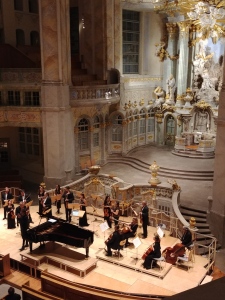 Situated on the Elbe River, it is now a modern, bustling city with one of the largest technical universities, a diverse economy and a vibrant nightlife – we managed to survive our first biergarten under the landmark bridge, the Blaues Wunder – the Blue Wonder.
Situated on the Elbe River, it is now a modern, bustling city with one of the largest technical universities, a diverse economy and a vibrant nightlife – we managed to survive our first biergarten under the landmark bridge, the Blaues Wunder – the Blue Wonder. 
 I find it comforting, even now, to see where my children live and work. It adds immeasurably to my future conversations to have a mental image of their kitchen, their office, their favourite patio, their quiet spot to decompress, their best biergarten.
I find it comforting, even now, to see where my children live and work. It adds immeasurably to my future conversations to have a mental image of their kitchen, their office, their favourite patio, their quiet spot to decompress, their best biergarten.  I am overjoyed. They are true intrepid explorers. I have high hopes of tagging along occasionally, using Dresden as a base for my own explorations and living vicariously through their adventures.
I am overjoyed. They are true intrepid explorers. I have high hopes of tagging along occasionally, using Dresden as a base for my own explorations and living vicariously through their adventures.  The Via Francigena is not for the easily distracted or for those who desire instant gratification; it’s a 2000 kilometre path that starts in Canterbury, England, traverses northern France then wends its way through Switzerland and crosses into Italy over the Great Saint Bernard Pass. That’s the halfway point; it ends in Rome after another 1000 kilometres of walking.
The Via Francigena is not for the easily distracted or for those who desire instant gratification; it’s a 2000 kilometre path that starts in Canterbury, England, traverses northern France then wends its way through Switzerland and crosses into Italy over the Great Saint Bernard Pass. That’s the halfway point; it ends in Rome after another 1000 kilometres of walking.  The Jura range near the border of France and Switzerland requires crossing; 1300 metres of elevation that I have not exactly planned for, a preview of things to come.
The Jura range near the border of France and Switzerland requires crossing; 1300 metres of elevation that I have not exactly planned for, a preview of things to come. 
 I have some R&R in Lausanne, an emotional visit to the Olympic museum, complete with artifacts from both Calgary 1988 and Vancouver 2010. I must admit wiping a bit of something that got caught in my eyes there, occasioned by fond memories of both. Again, taking my time pays off.
I have some R&R in Lausanne, an emotional visit to the Olympic museum, complete with artifacts from both Calgary 1988 and Vancouver 2010. I must admit wiping a bit of something that got caught in my eyes there, occasioned by fond memories of both. Again, taking my time pays off. Blair joins me in Lausanne and we are off. We haven’t done any walking together since his teenage years; it’s good to have him with me.
Blair joins me in Lausanne and we are off. We haven’t done any walking together since his teenage years; it’s good to have him with me.  He manages my slower pace by stopping to take photos while I trudge on; more importantly, vitally, he offers to carry all our water for the last two days, several extra kilograms of weight all day, all the way to the top.
He manages my slower pace by stopping to take photos while I trudge on; more importantly, vitally, he offers to carry all our water for the last two days, several extra kilograms of weight all day, all the way to the top. 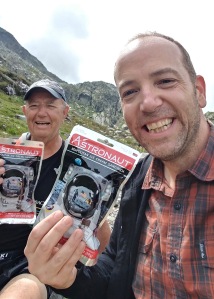 Finally, in late afternoon, within sight of the summit, Blair announces that he has a surprise for me; we can stop anywhere. The sun comes out, we find a flat rock and he pulls two Astronaut-ready freeze-dried ice cream sandwiches from his pack.
Finally, in late afternoon, within sight of the summit, Blair announces that he has a surprise for me; we can stop anywhere. The sun comes out, we find a flat rock and he pulls two Astronaut-ready freeze-dried ice cream sandwiches from his pack. 

 Walking in the north of Italy is a perfect end to my Via Francigena summer. Fruit trees are loaded, the villages are picturesque, the people are kind and helpful, the food is glorious. We slow down and walk with a keen eye for photos and a reluctance to see our shared adventure end.
Walking in the north of Italy is a perfect end to my Via Francigena summer. Fruit trees are loaded, the villages are picturesque, the people are kind and helpful, the food is glorious. We slow down and walk with a keen eye for photos and a reluctance to see our shared adventure end. 
 Last summer, I started a major walk; the Via Francegina, from Canterbury to Rome. It follows the path of Sigeric the Serious, the Archbishop of Canterbury who made the trek to be appointed Cardinal.
Last summer, I started a major walk; the Via Francegina, from Canterbury to Rome. It follows the path of Sigeric the Serious, the Archbishop of Canterbury who made the trek to be appointed Cardinal. 
 This year’s walk began where I finished last year, in Reims. I have a new travel companion, John will walk with me for two weeks.
This year’s walk began where I finished last year, in Reims. I have a new travel companion, John will walk with me for two weeks. The walk is beautiful, through Champagne wine country, down a long arrow-straight Roman road that is still functional as a farm track, through a major forest and finally out into open country. We manage to replenish our water, hitch a bit of a ride and arrive at our first lodging.
The walk is beautiful, through Champagne wine country, down a long arrow-straight Roman road that is still functional as a farm track, through a major forest and finally out into open country. We manage to replenish our water, hitch a bit of a ride and arrive at our first lodging. 

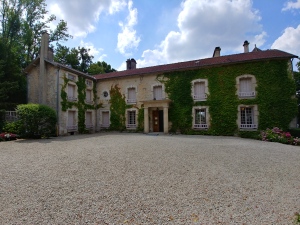


 John is an ideal companion; he is flexible and gets the everything-is-a-surprise concept quickly. He is happy with a simple hotel; neither of us complain much, we settle for what we receive and move on. We concentrate on the small kindnesses extended to us. The kindness comes, the tender mercies abound and accumulate.
John is an ideal companion; he is flexible and gets the everything-is-a-surprise concept quickly. He is happy with a simple hotel; neither of us complain much, we settle for what we receive and move on. We concentrate on the small kindnesses extended to us. The kindness comes, the tender mercies abound and accumulate. 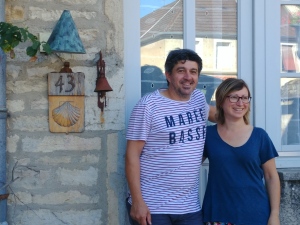
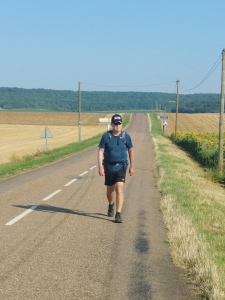 We’ve covered some 350 kilometres; my best guess is we’ve walked 250 of that. We have walked in temperatures exceeding 30 degrees Celsius, usually on tarmac with little shade with no access to water along the route. We’ve had fun, we’ve seen some sights, we’ve met some truly kind people and have benefited from their simple acts of kindness.
We’ve covered some 350 kilometres; my best guess is we’ve walked 250 of that. We have walked in temperatures exceeding 30 degrees Celsius, usually on tarmac with little shade with no access to water along the route. We’ve had fun, we’ve seen some sights, we’ve met some truly kind people and have benefited from their simple acts of kindness. Jos
Jos
 Stiglitz believes that the growing concentration of wealth and income in the top 1% of Americans, the greed that propels this continuing aggregation of wealth and the complicity of policy makers and elected officials to make the rich richer is the biggest challenge Americans face.
Stiglitz believes that the growing concentration of wealth and income in the top 1% of Americans, the greed that propels this continuing aggregation of wealth and the complicity of policy makers and elected officials to make the rich richer is the biggest challenge Americans face. It is my personal view that the current turmoil sweeping across America is directly related to the economic disparities that are cleaving American society. People are coming to understand that the American dream is available only to the 1%.
It is my personal view that the current turmoil sweeping across America is directly related to the economic disparities that are cleaving American society. People are coming to understand that the American dream is available only to the 1%. Leo
Leo Stiglitz is clear; inequality is a choice that American policy makers have made and continue to make. In the US Supreme Court’s decision in Citizen’s United, they have ensured that money rules the US political process. It almost guarantees that policy will ensure the rich get richer; everybody – even Leonard Cohen – knows.
Stiglitz is clear; inequality is a choice that American policy makers have made and continue to make. In the US Supreme Court’s decision in Citizen’s United, they have ensured that money rules the US political process. It almost guarantees that policy will ensure the rich get richer; everybody – even Leonard Cohen – knows.
 What’s history? In my schoolchild days it was a long, complicated series of dates and names to be memorized; kings and queens of western European countries, battles and maps and heroes and villains. It was dead white men of privilege exploring and conquering the world. While it could be exciting stuff for a child with an overactive imagination, it was pretty dull and boring.
What’s history? In my schoolchild days it was a long, complicated series of dates and names to be memorized; kings and queens of western European countries, battles and maps and heroes and villains. It was dead white men of privilege exploring and conquering the world. While it could be exciting stuff for a child with an overactive imagination, it was pretty dull and boring.  Later it became more serious. In my pipe-smoking undergraduate and graduate school days, the study of history was important because it gave us insight. I was in love with politics and policy, constantly admonished by my professors quoting George Santayana: “Those who cannot remember the past are condemned to repeat it.”
Later it became more serious. In my pipe-smoking undergraduate and graduate school days, the study of history was important because it gave us insight. I was in love with politics and policy, constantly admonished by my professors quoting George Santayana: “Those who cannot remember the past are condemned to repeat it.” Nothing so clearly points out the complexity of interpreting history than a book that formed the basis of my latest adventure.
Nothing so clearly points out the complexity of interpreting history than a book that formed the basis of my latest adventure. 
 While historians have proven the so-called decisive battle never actually happened, one historian noted; “
While historians have proven the so-called decisive battle never actually happened, one historian noted; “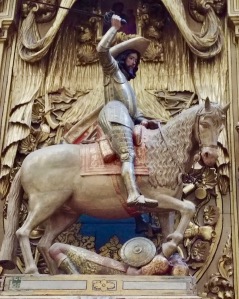 Saint James is celebrated with in art and sculpture, with a prominent position of honour in the Santiago Cathedral. I came across another Santiago de Matamoros statue in Granada while on my study course, trying to assess the impact of 700 years of Moorish domination of large swaths of what we now call Spain.
Saint James is celebrated with in art and sculpture, with a prominent position of honour in the Santiago Cathedral. I came across another Santiago de Matamoros statue in Granada while on my study course, trying to assess the impact of 700 years of Moorish domination of large swaths of what we now call Spain. 
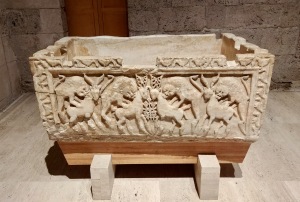 She describes a culture of architectural innovation, poetry, an explosion of learning, a multiplication of libraries and a reverence for intellectual discovery in science and medicine. She credits the Moors with the vital transfer of the ideas and philosophical debates of the Greeks to Europe. In the 10th century, Cordoba was one of the five largest cities in the world – London and Paris were riverside towns.
She describes a culture of architectural innovation, poetry, an explosion of learning, a multiplication of libraries and a reverence for intellectual discovery in science and medicine. She credits the Moors with the vital transfer of the ideas and philosophical debates of the Greeks to Europe. In the 10th century, Cordoba was one of the five largest cities in the world – London and Paris were riverside towns.  It is a positive and optimistic portrayal of a time when history was being made. To Menocal, the Muslim willingness to tolerate, engage and integrate Jews and Christians into their governance and society was the cause of this Golden Age, a renaissance that preceded and set the stage for Europe’s emergence from the dark ages.
It is a positive and optimistic portrayal of a time when history was being made. To Menocal, the Muslim willingness to tolerate, engage and integrate Jews and Christians into their governance and society was the cause of this Golden Age, a renaissance that preceded and set the stage for Europe’s emergence from the dark ages.  It’s not for lack of trying, Archeologists, anthropologists and historians have worked prodigiously to help us learn from history, for we do intuitively believe in Santayana’s maxim.
It’s not for lack of trying, Archeologists, anthropologists and historians have worked prodigiously to help us learn from history, for we do intuitively believe in Santayana’s maxim.  We all know that history has been written by and about men, that it is focused on conquest and war, ego and the glorification of aggression, that the post colonial world is awakening to a new narrative for their history, that women have made history without being acknowledged, that too little has been written about slow moving events that don’t follow a story-like narrative.
We all know that history has been written by and about men, that it is focused on conquest and war, ego and the glorification of aggression, that the post colonial world is awakening to a new narrative for their history, that women have made history without being acknowledged, that too little has been written about slow moving events that don’t follow a story-like narrative.  Santayana may be right, we should study our past, our many histories, our various perspectives on what happened, how and why it occurred. I am coming to believe that history is plural; it is a conflicting set of stories we tell ourselves. Stories will change over time, with new information, new insights, new voices claiming a share of the narrative.
Santayana may be right, we should study our past, our many histories, our various perspectives on what happened, how and why it occurred. I am coming to believe that history is plural; it is a conflicting set of stories we tell ourselves. Stories will change over time, with new information, new insights, new voices claiming a share of the narrative.  Franco ruled Spain as a dictator for more than 35 years yet It is difficult to find public evidence of his regime. The last Franco statue to be removed from public display was at Santander in 2008; continued attempts at reconciliation are ongoing and painful.
Franco ruled Spain as a dictator for more than 35 years yet It is difficult to find public evidence of his regime. The last Franco statue to be removed from public display was at Santander in 2008; continued attempts at reconciliation are ongoing and painful.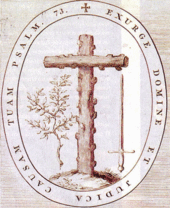 Similarly, the unbending repressive strain of Catholicism exhibited in Spain since Ferdinand and Isabella united the country in the late 15th century seems to be an uncomfortably sidelined part of Spanish history. The only reference to the infamous excesses of the Inquisition that I could find were in side-show ‘museums’ that duped unwitting tourists into parting with their Euros to see depictions of blood, gore and torture.
Similarly, the unbending repressive strain of Catholicism exhibited in Spain since Ferdinand and Isabella united the country in the late 15th century seems to be an uncomfortably sidelined part of Spanish history. The only reference to the infamous excesses of the Inquisition that I could find were in side-show ‘museums’ that duped unwitting tourists into parting with their Euros to see depictions of blood, gore and torture.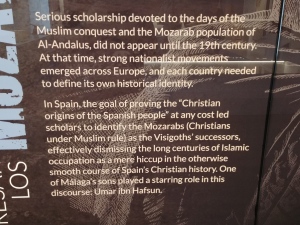 In a thoughtfully curated and reputable museum in Malaga, I came across the attached. Here’s part of the quote;
In a thoughtfully curated and reputable museum in Malaga, I came across the attached. Here’s part of the quote; This spring, I was part of a travel study group focused on the seven centuries of Islamic rule of southern Spain, generally agreed to have started in 711 with the invasion of Spain by Muslim Berbers. The conquest was swift and pervasive.
This spring, I was part of a travel study group focused on the seven centuries of Islamic rule of southern Spain, generally agreed to have started in 711 with the invasion of Spain by Muslim Berbers. The conquest was swift and pervasive.  In those seven centuries, the Islamic influence permeated medieval Spain, influenced intellectual thought in the rest of Europe and advanced knowledge and civilization in architecture, art, agriculture, irrigation and water usage, science in all its emerging forms. Libraries were created book-by-book that brought the greatest intellectual thoughts of Greece and Rome to Europeans for the first time. Through Cordoba. By Muslims.
In those seven centuries, the Islamic influence permeated medieval Spain, influenced intellectual thought in the rest of Europe and advanced knowledge and civilization in architecture, art, agriculture, irrigation and water usage, science in all its emerging forms. Libraries were created book-by-book that brought the greatest intellectual thoughts of Greece and Rome to Europeans for the first time. Through Cordoba. By Muslims.  Malaga has two major monuments, the Castillo de Gibralfaro – the fortress – and the Alcazaba – the adjacent fortified palace. The Castillo, a fortification since Phoenician times, was turned into a major Muslim fortress in the 11th century, conquered by the Christians in the late 15th century and used as a military fortification for most of the last centuries. The illustrations and explanations of the Castillo’s history at the on-site museum begins with the conquest of the site by the forces of Ferdinand and Isabella in 1487; one has to search for references to Muslim rule prior to that date.
Malaga has two major monuments, the Castillo de Gibralfaro – the fortress – and the Alcazaba – the adjacent fortified palace. The Castillo, a fortification since Phoenician times, was turned into a major Muslim fortress in the 11th century, conquered by the Christians in the late 15th century and used as a military fortification for most of the last centuries. The illustrations and explanations of the Castillo’s history at the on-site museum begins with the conquest of the site by the forces of Ferdinand and Isabella in 1487; one has to search for references to Muslim rule prior to that date.

 Seville provided another perspective on Moorish Spain. We arrived on a very hot sunny day; our first visit, the Seville Cathedral. Built on the site of the mosque, it is the third largest cathedral in the world; overwhelming does not cover my reaction to this is a need to sit for a few minutes – it is an assault on the senses.
Seville provided another perspective on Moorish Spain. We arrived on a very hot sunny day; our first visit, the Seville Cathedral. Built on the site of the mosque, it is the third largest cathedral in the world; overwhelming does not cover my reaction to this is a need to sit for a few minutes – it is an assault on the senses. The Gothic structure has been built upon and altered so many times that it is now an unreconcilable mish-mash of a host of evolving architectural styles; add-ons offer a dizzying array of chapels, stalls, aisles, walls, altars, side attractions, all further confused by dazzling golden altars, bas-relief art, figurines, monuments, columns and pillars. It is dazzling – living up to a quote found in a guide book – “When they see it, future generations will think we are mad.”
The Gothic structure has been built upon and altered so many times that it is now an unreconcilable mish-mash of a host of evolving architectural styles; add-ons offer a dizzying array of chapels, stalls, aisles, walls, altars, side attractions, all further confused by dazzling golden altars, bas-relief art, figurines, monuments, columns and pillars. It is dazzling – living up to a quote found in a guide book – “When they see it, future generations will think we are mad.”  An hour later, we entered the Alcazar; the contrast to the Cathedral was profound. Rather than feeling overwhelmed, I immediately felt calmed, almost serene.
An hour later, we entered the Alcazar; the contrast to the Cathedral was profound. Rather than feeling overwhelmed, I immediately felt calmed, almost serene. 

 Isabel, the Spanish monarch who led the final stage of the Reconquesta, was so taken with the beauty of the Alhambra that she was buried there for a short time until her remains were removed to the Royal Chapel in the Granada Cathedral. Such was her judgement of the beauty of the Alhambra.
Isabel, the Spanish monarch who led the final stage of the Reconquesta, was so taken with the beauty of the Alhambra that she was buried there for a short time until her remains were removed to the Royal Chapel in the Granada Cathedral. Such was her judgement of the beauty of the Alhambra.  The grounds are extensive, the palace buildings the most necessary of many attractions in the 13 hectare site. Here a succession of small rooms, pleasingly sized and each in its own right a marvel, open to more rooms, larger and more ornate. The effect is to induce a greater sense of awe as one moves through each passage. It works.
The grounds are extensive, the palace buildings the most necessary of many attractions in the 13 hectare site. Here a succession of small rooms, pleasingly sized and each in its own right a marvel, open to more rooms, larger and more ornate. The effect is to induce a greater sense of awe as one moves through each passage. It works.  The use of light and shadow, the constant presence of water and the specific placement of windows for views and to catch the breezes ensures that the temperature is moderate. Even in the mid-day heat, we were cooled. Even in the cacophony of the never ending stream of tourists, we were calmed; the rooms were more peaceful, quieter than they should be.
The use of light and shadow, the constant presence of water and the specific placement of windows for views and to catch the breezes ensures that the temperature is moderate. Even in the mid-day heat, we were cooled. Even in the cacophony of the never ending stream of tourists, we were calmed; the rooms were more peaceful, quieter than they should be.  I cannot claim to have more than a superficial impression of the centuries of Moorish dominion over Spain. I know that the jewels in the crown of Spanish history that may be the least favorite are also the most dazzling – the architecture of three sites in Cordoba, Seville and Granada are all must-see wonders of the world. If, even in a small way, they represent the impact of the Moorish ruling period, the Spanish people should be grateful for such enrichment. Menocal’s book, Ornament of the World is subtitled
I cannot claim to have more than a superficial impression of the centuries of Moorish dominion over Spain. I know that the jewels in the crown of Spanish history that may be the least favorite are also the most dazzling – the architecture of three sites in Cordoba, Seville and Granada are all must-see wonders of the world. If, even in a small way, they represent the impact of the Moorish ruling period, the Spanish people should be grateful for such enrichment. Menocal’s book, Ornament of the World is subtitled  At about this time five years ago, we gathered to send them off; reminding them constantly that home would stay where it always was – in our hearts and in the hearts of our family and friends. Home is a feeling not a place. We could and would visit back and forth; Vancouver would patiently await their return.
At about this time five years ago, we gathered to send them off; reminding them constantly that home would stay where it always was – in our hearts and in the hearts of our family and friends. Home is a feeling not a place. We could and would visit back and forth; Vancouver would patiently await their return. It happened quickly; I used Christopher’s world triathlon competition in London that year as a jumping-off point for my first pilgrimage, an 800 km walk on the Camino de Santiago in Spain. He finished his triathlon and went on to Basel and I left to start the Camino.
It happened quickly; I used Christopher’s world triathlon competition in London that year as a jumping-off point for my first pilgrimage, an 800 km walk on the Camino de Santiago in Spain. He finished his triathlon and went on to Basel and I left to start the Camino.  The prize I dangled in front of myself was a visit in Basel, complete with my first fondue and a few days of R&R in my new home after a month of vagabonding. It worked so well, I did it again a few years later in Portugal.
The prize I dangled in front of myself was a visit in Basel, complete with my first fondue and a few days of R&R in my new home after a month of vagabonding. It worked so well, I did it again a few years later in Portugal. 
 Base camp Basel was the jumping off point for our African safari and the place we returned to when we had finished our glorious adventure.
Base camp Basel was the jumping off point for our African safari and the place we returned to when we had finished our glorious adventure.  Base camp that allowed us to experience the total insanity of Swiss Fasnacht, the only time the Swiss drop their massive stuffiness and go crazy, worshipping fire, parading through the streets at odd hours; a long stream of weird fife and drum bands, the oddest parade floats, even odder costumes fuelled by the consumption of vast quantities of alcohol. Carnival in Rio is choir-like by comparison.
Base camp that allowed us to experience the total insanity of Swiss Fasnacht, the only time the Swiss drop their massive stuffiness and go crazy, worshipping fire, parading through the streets at odd hours; a long stream of weird fife and drum bands, the oddest parade floats, even odder costumes fuelled by the consumption of vast quantities of alcohol. Carnival in Rio is choir-like by comparison. 
 Kristen walked me all over Switzerland, winter and summer. We rode sledges down steep ski slopes, we wanderwegged through the Jungfrau in the shadow of the Eiger. We hiked up to Heidi’s village. We
Kristen walked me all over Switzerland, winter and summer. We rode sledges down steep ski slopes, we wanderwegged through the Jungfrau in the shadow of the Eiger. We hiked up to Heidi’s village. We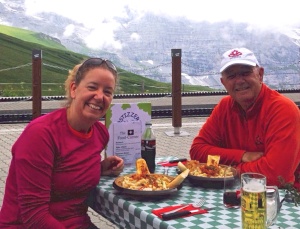 We ate magnificently at the end of every hike ; sausages and cheese and mountain macaroni – guiltless extravagance. In fact we ate well every time I visited.
We ate magnificently at the end of every hike ; sausages and cheese and mountain macaroni – guiltless extravagance. In fact we ate well every time I visited. 
 We stood in the stands cheering a pickup team of Canadians playing in various European leagues who come together every year at the Spengler cup in Davos, more pure joy in one game than in any I’ve seen in the NHL lately – Gary Bettman are you listening?
We stood in the stands cheering a pickup team of Canadians playing in various European leagues who come together every year at the Spengler cup in Davos, more pure joy in one game than in any I’ve seen in the NHL lately – Gary Bettman are you listening?  Base camp Basel became the meeting point for adventures all over Europe. Italian Espresso and a foodie tour in Rome, the final Bruce Springsteen European concert in Zurich, Lisbon for the best Pasteis de Nata ever!, Paris and more Paris, Varengeville for dinner, and Krakow in winter.
Base camp Basel became the meeting point for adventures all over Europe. Italian Espresso and a foodie tour in Rome, the final Bruce Springsteen European concert in Zurich, Lisbon for the best Pasteis de Nata ever!, Paris and more Paris, Varengeville for dinner, and Krakow in winter. 
 I signed up for Twitter about a month ago; Trump tweets were the catnip for joining. I NEEDED to see Trump’s tweets directly; news casts blaring BREAKING NEWS and showing me the feeds were not enough.
I signed up for Twitter about a month ago; Trump tweets were the catnip for joining. I NEEDED to see Trump’s tweets directly; news casts blaring BREAKING NEWS and showing me the feeds were not enough. 
 I glance at the CBC and CTV morning news, finish my coffee, check Facebook and go about my day. All this consumed about an hour of my time.
I glance at the CBC and CTV morning news, finish my coffee, check Facebook and go about my day. All this consumed about an hour of my time.
 I was digging myself out, then Facebook hit the fan. With Blair’s help, I have immediately tightened my privacy settings and blocked all the apps from accessing my information. I have never knowingly allowed Facebook or any of my digital tools to access my address book or my contacts. Knowingly is the key word in that sentence. I’m convinced now that, like millions of others, I am not very KNOWING.
I was digging myself out, then Facebook hit the fan. With Blair’s help, I have immediately tightened my privacy settings and blocked all the apps from accessing my information. I have never knowingly allowed Facebook or any of my digital tools to access my address book or my contacts. Knowingly is the key word in that sentence. I’m convinced now that, like millions of others, I am not very KNOWING.  The privacy thing is long gone; everyone tells me that the digital universe has enough data on each of us that we are an open book. Data doesn’t disappear apparently.
The privacy thing is long gone; everyone tells me that the digital universe has enough data on each of us that we are an open book. Data doesn’t disappear apparently. I also recognize that I am my own worst enemy. I write a blog for goodness sake. I’ve written two books. I post all these musings on Facebook so more people will benefit from my wisdom ( a dubious rationale but it’s all I can cling to at the moment).
I also recognize that I am my own worst enemy. I write a blog for goodness sake. I’ve written two books. I post all these musings on Facebook so more people will benefit from my wisdom ( a dubious rationale but it’s all I can cling to at the moment).  I have decided, despite knowing that this will be a pain in the butt, I’m moving my bank accounts to Vancity, a British Columbia credit union with more than 500,000 members. Vancity is everywhere in my community; sponsoring local community events, offering innovative business partnership opportunities, supporting environmental initiatives and stimulating the development of affordable housing. Vancity also returns part of its profits to members. They WORK at being a positive member of my community.
I have decided, despite knowing that this will be a pain in the butt, I’m moving my bank accounts to Vancity, a British Columbia credit union with more than 500,000 members. Vancity is everywhere in my community; sponsoring local community events, offering innovative business partnership opportunities, supporting environmental initiatives and stimulating the development of affordable housing. Vancity also returns part of its profits to members. They WORK at being a positive member of my community. Again, I’m late but I have come to the conclusion that the largest threat to civil society is the enormous gap between the rich and the poor – the obscene aggregation of wealth by a small percentage of people and the growing impoverishment of the rest of us. This aggregation of wealth is fuelled by the growth in large corporations, the power of these interests to dominate markets and dictate prices, wages and government policies to benefit the richest few – owners, senior executives and shareholders – whilst impoverishing other stakeholders.
Again, I’m late but I have come to the conclusion that the largest threat to civil society is the enormous gap between the rich and the poor – the obscene aggregation of wealth by a small percentage of people and the growing impoverishment of the rest of us. This aggregation of wealth is fuelled by the growth in large corporations, the power of these interests to dominate markets and dictate prices, wages and government policies to benefit the richest few – owners, senior executives and shareholders – whilst impoverishing other stakeholders.  Permit me one example; Walmart. The Walton family’s net worth is estimated by Forbes magazine to be in excess of $140 billion – yes, that’s right BILLION. Bernie Sanders describes it this way, the Waltons own more than the bottom 40% of Americans – about 130 million people. In exchange for convenience and cheap goods, consumers have created a behemoth that rolls over competitors, overpowers suppliers, kills local business wherever it goes, impoverishes it’s own employees, and hollows out communities while making its owners fabulously wealthy.
Permit me one example; Walmart. The Walton family’s net worth is estimated by Forbes magazine to be in excess of $140 billion – yes, that’s right BILLION. Bernie Sanders describes it this way, the Waltons own more than the bottom 40% of Americans – about 130 million people. In exchange for convenience and cheap goods, consumers have created a behemoth that rolls over competitors, overpowers suppliers, kills local business wherever it goes, impoverishes it’s own employees, and hollows out communities while making its owners fabulously wealthy. The middle class is shrinking, poverty is growing, the stresses on civil society are becoming more and more evident. Governments around the world are less willing to legislate, regulate and control these monsters; the 2008/2009 world financial crash showed starkly that banks and other large institutions were too big to fail and, even in the face of obvious legal culpability, were immune to prosecution. Even Obama blinked when he faced Wall Street and the banks.
The middle class is shrinking, poverty is growing, the stresses on civil society are becoming more and more evident. Governments around the world are less willing to legislate, regulate and control these monsters; the 2008/2009 world financial crash showed starkly that banks and other large institutions were too big to fail and, even in the face of obvious legal culpability, were immune to prosecution. Even Obama blinked when he faced Wall Street and the banks. I have vowed to never shop at Walmart. Instead, I’m going to buy locally – there’s a little hardware store where I can find all I need; and I am welcomed with helpful advice and service by a member of my community.
I have vowed to never shop at Walmart. Instead, I’m going to buy locally – there’s a little hardware store where I can find all I need; and I am welcomed with helpful advice and service by a member of my community.
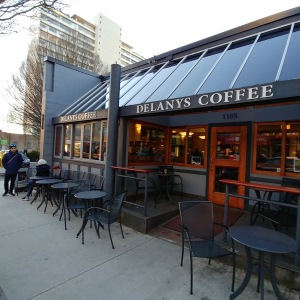 I don’t buy coffee at Starbucks, my local hangout is Delaneys. Locally owned by nicer people who treat their staff well. The coffee is better too!
I don’t buy coffee at Starbucks, my local hangout is Delaneys. Locally owned by nicer people who treat their staff well. The coffee is better too! An Indian restaurant in the center of an iconic Swiss destination becomes understandable when Kristen and Chris explain that the Jungfrau has featured in several famously successful Bollywood movies, as far back as 1964. Yash Chopra, the famous Indian film director, has shot so many sequences for so many films over the years that the region has become one of the top destinations for Indian tourists – hence the Bollywood restaurant. He’s so famous, a Jungfrau railway train has been named after him.
An Indian restaurant in the center of an iconic Swiss destination becomes understandable when Kristen and Chris explain that the Jungfrau has featured in several famously successful Bollywood movies, as far back as 1964. Yash Chopra, the famous Indian film director, has shot so many sequences for so many films over the years that the region has become one of the top destinations for Indian tourists – hence the Bollywood restaurant. He’s so famous, a Jungfrau railway train has been named after him. It isn’t just India, many of the Bond films over the years have featured the mountains of Switzerland. A not-so-good Clint Eastwood film, The Eiger Sanction – based on the best-selling novel – was centred on the Jungfrau. There have even been a few clips from Star Wars with the Jungfrau as backdrop.
It isn’t just India, many of the Bond films over the years have featured the mountains of Switzerland. A not-so-good Clint Eastwood film, The Eiger Sanction – based on the best-selling novel – was centred on the Jungfrau. There have even been a few clips from Star Wars with the Jungfrau as backdrop. We are in Grindelwald for a Swiss Christmas. Nestled below the Jungfrau range, it is a gateway for hiking, mountain-biking and marvelling in the summer and a whole range of outdoor pursuits in the winter. We are attracted for the same reason as Bollywood directors, it is an oasis of Swiss beauty.
We are in Grindelwald for a Swiss Christmas. Nestled below the Jungfrau range, it is a gateway for hiking, mountain-biking and marvelling in the summer and a whole range of outdoor pursuits in the winter. We are attracted for the same reason as Bollywood directors, it is an oasis of Swiss beauty. 
 After our al fresco lunch of the best Swiss macaroni EVER!!!, we settled into a local hotel and stared at the Jungfrau for hours. Like a poor man’s fireplace, the clouds, the sun, the light and shadows created a panoramic reel of ever-changing perfection, enhancing the endorphins released by the walk and the sublime somnolence that comes from a full tummy.
After our al fresco lunch of the best Swiss macaroni EVER!!!, we settled into a local hotel and stared at the Jungfrau for hours. Like a poor man’s fireplace, the clouds, the sun, the light and shadows created a panoramic reel of ever-changing perfection, enhancing the endorphins released by the walk and the sublime somnolence that comes from a full tummy.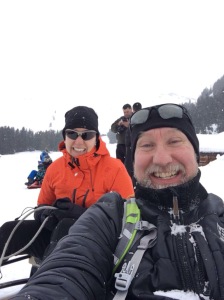
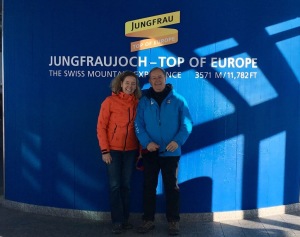 I’m encouraged to visit Jungfraujoch. At 3454 metres, it calls itself the Top of Europe. The Jungfrau (4158 meters) is the namesake; aligned with it in a massive wall of mountain that leaps from the lower valley of Interlaken are the Eiger (3970 metres) and the Monsch (4107 metres).
I’m encouraged to visit Jungfraujoch. At 3454 metres, it calls itself the Top of Europe. The Jungfrau (4158 meters) is the namesake; aligned with it in a massive wall of mountain that leaps from the lower valley of Interlaken are the Eiger (3970 metres) and the Monsch (4107 metres).  This time we take the trains, I’ve walked part of this once, no bragging points in doing it again. The Bernese Oberland Railway is a marvel of Swiss design and efficiency; constructed at the turned of the 20th century, it connects Grindelwald with the funicular Jungfrau railway that takes up to the Jungfraujoch. Most of the passage is tunneled through the granite of the Jungfrau – there’s a stop allowing us to view the valley through a window cut in the mountain face.
This time we take the trains, I’ve walked part of this once, no bragging points in doing it again. The Bernese Oberland Railway is a marvel of Swiss design and efficiency; constructed at the turned of the 20th century, it connects Grindelwald with the funicular Jungfrau railway that takes up to the Jungfraujoch. Most of the passage is tunneled through the granite of the Jungfrau – there’s a stop allowing us to view the valley through a window cut in the mountain face. Jungfraujoch is a complex built into the mountains in the shadow of Jungfrau itself. At the top is an observation viewpoint allowing a full 360 degree view of the valleys and the Aletsch Glacier. Deep inside the mountain is the funicular station, a state-of-the-art film tunnel, a glacier walkway, an interior ice palace, a chocolate shop and a watch shop and among others, our favorite Bollywood restaurant. Everything the modern tourist needs and a chance to buy Swiss watches, Swiss chocolate and Indian curries.
Jungfraujoch is a complex built into the mountains in the shadow of Jungfrau itself. At the top is an observation viewpoint allowing a full 360 degree view of the valleys and the Aletsch Glacier. Deep inside the mountain is the funicular station, a state-of-the-art film tunnel, a glacier walkway, an interior ice palace, a chocolate shop and a watch shop and among others, our favorite Bollywood restaurant. Everything the modern tourist needs and a chance to buy Swiss watches, Swiss chocolate and Indian curries.
 It has been described as one of the 10 most influential books in a survey of American readers.
It has been described as one of the 10 most influential books in a survey of American readers. 


 Frankl’s philosophy is simple; I need meaning in my life and, while I may not be in control of events that occur in my life, I am in control of how I respond to them and how I seek to manage that part of my life that is under my control. I have the power to choose.
Frankl’s philosophy is simple; I need meaning in my life and, while I may not be in control of events that occur in my life, I am in control of how I respond to them and how I seek to manage that part of my life that is under my control. I have the power to choose.  My first response to anyone who asks, ‘what do you think about when you walk?’ is always ‘nothing.’
My first response to anyone who asks, ‘what do you think about when you walk?’ is always ‘nothing.’

 I needed a bigger platform. I began writing the occasional column for the Calgary Herald. I received no money but felt that rush of ego and adrenaline coursing through my veins when I opened the Herald to the op-ed page and saw MY column – WOW!
I needed a bigger platform. I began writing the occasional column for the Calgary Herald. I received no money but felt that rush of ego and adrenaline coursing through my veins when I opened the Herald to the op-ed page and saw MY column – WOW!  Running helped break through my inarticulate efforts to write, when I became a walker, the occasional inspiration became regular. There is something about the pace of walking, the slowness, the repetitiveness, the almost boring simplicity of the walk that seems to energize the subconscious – the Muse.
Running helped break through my inarticulate efforts to write, when I became a walker, the occasional inspiration became regular. There is something about the pace of walking, the slowness, the repetitiveness, the almost boring simplicity of the walk that seems to energize the subconscious – the Muse.  Walking allows for the clearing of the brain; the period after, rest and contemplation, opens the floodgates of creativity and inspiration. Newton may have conceived and clarified his thoughts on gravity while sitting under a tree. Could I be so bold as to suggest that he had a bit of a walk to get to the tree?
Walking allows for the clearing of the brain; the period after, rest and contemplation, opens the floodgates of creativity and inspiration. Newton may have conceived and clarified his thoughts on gravity while sitting under a tree. Could I be so bold as to suggest that he had a bit of a walk to get to the tree? 
 Over the past few years, I have become a walker, a hiker, a trekker, a wanderer, a rambler and, later in the day, a trudger and a plodder.
Over the past few years, I have become a walker, a hiker, a trekker, a wanderer, a rambler and, later in the day, a trudger and a plodder.  My penchant for walking is relatively recent; age and circumstance play their part. I’ve retired from a decade of running, cycling has become inordinately dangerous here in Vancouver, swimming is too much trouble, triathlons are too complicated.
My penchant for walking is relatively recent; age and circumstance play their part. I’ve retired from a decade of running, cycling has become inordinately dangerous here in Vancouver, swimming is too much trouble, triathlons are too complicated. 
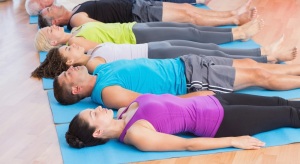

 There is even a highly recommended book, How to Walk by the renowned buddhist Thich Nhat Hanh. It’s small, with short statements that are either deeply profound or borderline banal.
There is even a highly recommended book, How to Walk by the renowned buddhist Thich Nhat Hanh. It’s small, with short statements that are either deeply profound or borderline banal.  Stories abound in Buddhist literature of others persisting for thousands of hours of sitting quietly seeking the fruits of meditation, they hung over me. I come by my guilt-driven personality honestly and I polish it up regularly. It must be me! I am deficient! I am not as smart, driven, committed, insightful, as thousands who achieve a measure of nirvana through meditation.
Stories abound in Buddhist literature of others persisting for thousands of hours of sitting quietly seeking the fruits of meditation, they hung over me. I come by my guilt-driven personality honestly and I polish it up regularly. It must be me! I am deficient! I am not as smart, driven, committed, insightful, as thousands who achieve a measure of nirvana through meditation. 
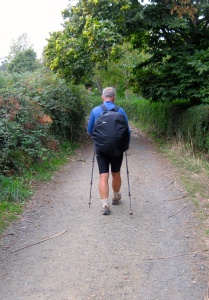
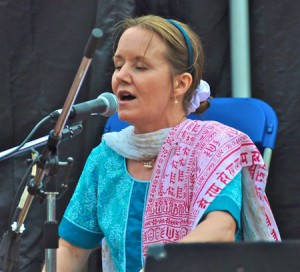 When I moved to Vancouver in early January of 1999, I moved into the West End, a small enclave near downtown Vancouver. My backyard, literally, is Stanley Park. The West End became my community, MY hood.
When I moved to Vancouver in early January of 1999, I moved into the West End, a small enclave near downtown Vancouver. My backyard, literally, is Stanley Park. The West End became my community, MY hood. In the heart of my hood is the West End community center. The community center vibrates with activity; most importantly for us was the offer of yoga classes. We needed a bit of help to stay loose, especially after long Sunday runs.
In the heart of my hood is the West End community center. The community center vibrates with activity; most importantly for us was the offer of yoga classes. We needed a bit of help to stay loose, especially after long Sunday runs. My friends held my hand and nurtured me through the door. There we met Sandra, petite, bubbly, as full of fresh-faced energy as the energizer bunny and as enthusiastic as Pippy Longstocking. She was the ideal yoga instructor; central casting couldn’t have done a better job.
My friends held my hand and nurtured me through the door. There we met Sandra, petite, bubbly, as full of fresh-faced energy as the energizer bunny and as enthusiastic as Pippy Longstocking. She was the ideal yoga instructor; central casting couldn’t have done a better job. 
 Sandra has become an icon for me and a glowing example of what it is to be a member of a vibrant community
Sandra has become an icon for me and a glowing example of what it is to be a member of a vibrant community 
 Her carefully chosen program offers movement, stories, jokes, guidance on everything from nutrition to the circadian rhythms, to the impact of sun, moon and seasons on our physical, emotional and spiritual lives. Her warmth, her inclusiveness, her genuine enthusiasm for life are all contagious.
Her carefully chosen program offers movement, stories, jokes, guidance on everything from nutrition to the circadian rhythms, to the impact of sun, moon and seasons on our physical, emotional and spiritual lives. Her warmth, her inclusiveness, her genuine enthusiasm for life are all contagious.  Sandra keeps growing; she has come a long way since those first days in 1999.
Sandra keeps growing; she has come a long way since those first days in 1999.  Fred Rogers said that in times of difficulty we should look to the helpers.
Fred Rogers said that in times of difficulty we should look to the helpers. 

 I find a visit to any country ignites an interest and a curiosity to know more.
I find a visit to any country ignites an interest and a curiosity to know more.
 The Chinese have developed a love affair with cement. Apartment buildings sprout like mushrooms after a rain – ten towers each of 20 some stories sprout everywhere. The accusation that some of these instant cities are ghost towns misses the point – they are huge, modern and a step up from the sprawling slums that exist outside most international urban areas. We know that the biggest mass exodus in modern times is the movement of people from rural to urban centers; the Chinese can mostly be accused of anticipating the inevitable and preparing for it.
The Chinese have developed a love affair with cement. Apartment buildings sprout like mushrooms after a rain – ten towers each of 20 some stories sprout everywhere. The accusation that some of these instant cities are ghost towns misses the point – they are huge, modern and a step up from the sprawling slums that exist outside most international urban areas. We know that the biggest mass exodus in modern times is the movement of people from rural to urban centers; the Chinese can mostly be accused of anticipating the inevitable and preparing for it.

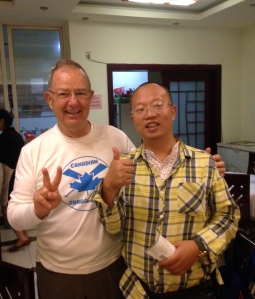 On our arrival in Mt. Emei for our stay at the buddhist temple at Baoguo, we were met by Patrick (his ‘western’ name). Six years ago, Kristen and Chris had also met Patrick; back then, he was the local agent for the monastery, helped them get settled, rented them a towel, sold some sandwiches and snacks, gave some advice on how to spend their day near this religious site and puttered about trying to be useful.
On our arrival in Mt. Emei for our stay at the buddhist temple at Baoguo, we were met by Patrick (his ‘western’ name). Six years ago, Kristen and Chris had also met Patrick; back then, he was the local agent for the monastery, helped them get settled, rented them a towel, sold some sandwiches and snacks, gave some advice on how to spend their day near this religious site and puttered about trying to be useful.

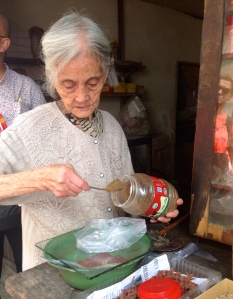
 the Chinese ‘wine‘ maker (it is awful hootch that knocks your head off) who hosts an impromptu ‘wine-tasting‘ for us in the street in front of his store,
the Chinese ‘wine‘ maker (it is awful hootch that knocks your head off) who hosts an impromptu ‘wine-tasting‘ for us in the street in front of his store,  the elderly tea plantation owner whose son now runs the place, with modern equipment and expanded acreage.
the elderly tea plantation owner whose son now runs the place, with modern equipment and expanded acreage.  Air pollution is palpable. The sky is brown in every major city, mainly the result of coal-fired electricity generation. Water supply and pollution problems loom, land use and desertification issues are faced daily,
Air pollution is palpable. The sky is brown in every major city, mainly the result of coal-fired electricity generation. Water supply and pollution problems loom, land use and desertification issues are faced daily,  Another poison leaching into the system is corruption on a massive scale; millions have already been punished. Xi Jinping has promised further crackdowns.
Another poison leaching into the system is corruption on a massive scale; millions have already been punished. Xi Jinping has promised further crackdowns.  Xi Jinping, at the recent Chinese Communist Party Congress, set future policy; “socialism with Chinese characteristics for a new era” now officially enshrined in the Chinese Constitution. How this evolves will be interesting, to them and to us.
Xi Jinping, at the recent Chinese Communist Party Congress, set future policy; “socialism with Chinese characteristics for a new era” now officially enshrined in the Chinese Constitution. How this evolves will be interesting, to them and to us.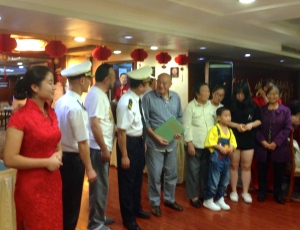 The mood is buoyant, people have jobs, small businesses, money and hope; we saw an outpouring of pride on National Day, 500 million people have escaped grinding poverty and tasted the good life, they will inevitably want more.
The mood is buoyant, people have jobs, small businesses, money and hope; we saw an outpouring of pride on National Day, 500 million people have escaped grinding poverty and tasted the good life, they will inevitably want more. What is clear to me is that China has joined the world, their problems are our problems, the messiness of life is now theirs to manage as we seek to manage our messiness. As one of the largest, if not THE largest economy in the world, what happens in China matters to us all.
What is clear to me is that China has joined the world, their problems are our problems, the messiness of life is now theirs to manage as we seek to manage our messiness. As one of the largest, if not THE largest economy in the world, what happens in China matters to us all. My primary purpose in visiting China was as a tourist; to see the sights, taste the food, hear the sounds, experience the reality. It is after all a foreign place.
My primary purpose in visiting China was as a tourist; to see the sights, taste the food, hear the sounds, experience the reality. It is after all a foreign place. 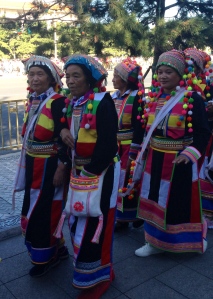
 The Forbidden City, adjacent and two kilometers long in its own magnificent sprawl, dwarfs Tiannamen Square. While the Forbidden City is a must-see, I have to bring my imagination with me; we are allowed only to see the external buildings and read carefully edited signs, we are not allowed access to the interior. There are a few exceptions where doors are open and we may jostle our way to the front of deep crowds of selfie-seekers, an exercise in cultural politeness. Without a vivid imagination, I’m incapable of fully appreciating this icon. There doesn’t seem to be much there there.
The Forbidden City, adjacent and two kilometers long in its own magnificent sprawl, dwarfs Tiannamen Square. While the Forbidden City is a must-see, I have to bring my imagination with me; we are allowed only to see the external buildings and read carefully edited signs, we are not allowed access to the interior. There are a few exceptions where doors are open and we may jostle our way to the front of deep crowds of selfie-seekers, an exercise in cultural politeness. Without a vivid imagination, I’m incapable of fully appreciating this icon. There doesn’t seem to be much there there.  The Great Wall fulfills its promise. It is GREAT. It doesn’t make sense; even in its visual grandeur, it seems to aimlessly meander off into both distant horizons. I try to imagine the sacrifice of those serfs, slaves and citizens in building it; I also try to imagine it being manned by an alert army of watchmen and defended from alien hordes who regularly breached its walls.
The Great Wall fulfills its promise. It is GREAT. It doesn’t make sense; even in its visual grandeur, it seems to aimlessly meander off into both distant horizons. I try to imagine the sacrifice of those serfs, slaves and citizens in building it; I also try to imagine it being manned by an alert army of watchmen and defended from alien hordes who regularly breached its walls.  Shanghai’s architecture exemplifies an interesting historical juxtaposition. On one side of the river is the Bund, a long boulevard of 1900’s buildings created by the European colonial powers to celebrate their superiority and their dominance of China for a period; across the river, the new Shanghai – postmodern architecture bursting with the vitality and exuberance of the 21st century.
Shanghai’s architecture exemplifies an interesting historical juxtaposition. On one side of the river is the Bund, a long boulevard of 1900’s buildings created by the European colonial powers to celebrate their superiority and their dominance of China for a period; across the river, the new Shanghai – postmodern architecture bursting with the vitality and exuberance of the 21st century.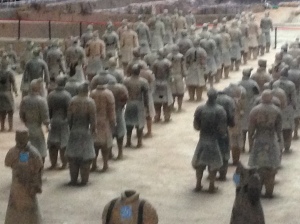
 After all this, connected by the unexpected but memorable (I can’t think of a more polite descriptor) trip on a Chinese overnight train, we needed a break. Overnight trains are democratic; six bunks per partition, a few seats in the aisle, room to store a bag overhead, a pillow and a ‘comforter’, ample hot water for tea and noodles, one communal sink and Asian style toilet per car. The upper bunk is the most private, it takes a contortionist/gymnast to climb there, and even more dexterity to climb down. An adventure in its own right – shattered image – tourist friendly travel hasn’t arrived everywhere in China.
After all this, connected by the unexpected but memorable (I can’t think of a more polite descriptor) trip on a Chinese overnight train, we needed a break. Overnight trains are democratic; six bunks per partition, a few seats in the aisle, room to store a bag overhead, a pillow and a ‘comforter’, ample hot water for tea and noodles, one communal sink and Asian style toilet per car. The upper bunk is the most private, it takes a contortionist/gymnast to climb there, and even more dexterity to climb down. An adventure in its own right – shattered image – tourist friendly travel hasn’t arrived everywhere in China.  The Buddhist monastery at Baoguo Temple, Mount Emei provided our oasis of calm serenity. We were permitted to stay inside the monastery overnight – afforded access to the same luxuries as monks, (communal showers open 5:30-9:30 pm every night, ample hot water, comfortable beds, private rooms, shared toilets) and the opportunity to witness morning prayers – announced by gongs and chimes at 5am, prayers at 5:30.
The Buddhist monastery at Baoguo Temple, Mount Emei provided our oasis of calm serenity. We were permitted to stay inside the monastery overnight – afforded access to the same luxuries as monks, (communal showers open 5:30-9:30 pm every night, ample hot water, comfortable beds, private rooms, shared toilets) and the opportunity to witness morning prayers – announced by gongs and chimes at 5am, prayers at 5:30.  It was a privilege, to some of us at least, and a refreshing change from the cacophony of the past week. Peace. calm, serenity; I now understand the attraction of Buddhism!
It was a privilege, to some of us at least, and a refreshing change from the cacophony of the past week. Peace. calm, serenity; I now understand the attraction of Buddhism! The Pandas were, well, pandas. They eat, they sleep, they change positions occasionally to affirm they are alive. Pandas are only found in China; the Chinese have found gold in their exclusivity. I was cautioned that they were hard selling their exclusivity; Kristen specifically told me to NOT join the long lineups that allow visitors to cuddle a panda – for a fee. Shattered image, they have created an enviable parklike setting for their pandas, they seem to have developed a responsible program working with zoos around the world to display and support Pandas, the World Wildlife Fund uses the Panda as their international symbol and they discontinued their ‘cuddle’ program – the poor panda died from too much human contact and kindness. The Chinese have taken responsibility for Pandas, now cherished and protected. Shattered Image.
The Pandas were, well, pandas. They eat, they sleep, they change positions occasionally to affirm they are alive. Pandas are only found in China; the Chinese have found gold in their exclusivity. I was cautioned that they were hard selling their exclusivity; Kristen specifically told me to NOT join the long lineups that allow visitors to cuddle a panda – for a fee. Shattered image, they have created an enviable parklike setting for their pandas, they seem to have developed a responsible program working with zoos around the world to display and support Pandas, the World Wildlife Fund uses the Panda as their international symbol and they discontinued their ‘cuddle’ program – the poor panda died from too much human contact and kindness. The Chinese have taken responsibility for Pandas, now cherished and protected. Shattered Image.  We cruise down the Yangtze River from Chongqing, a city engorged with the displaced peasants from the flooding of the Three Gorges Dam – now with a population greater than all of Canada. Yes, 30 million people in one “city”.
We cruise down the Yangtze River from Chongqing, a city engorged with the displaced peasants from the flooding of the Three Gorges Dam – now with a population greater than all of Canada. Yes, 30 million people in one “city”. Finally, Hong Kong. Glitz and glitter, hustle and bustle. Yet its impressive skyline is rivalled by Shanghai, it’s entrepreneurial activity dwarfed by dozens of mainland China cities, it’s faint hope for special status diminished regularly. Is the rest of China catching up or is Hong Kong being pulled back into the pot with the others?
Finally, Hong Kong. Glitz and glitter, hustle and bustle. Yet its impressive skyline is rivalled by Shanghai, it’s entrepreneurial activity dwarfed by dozens of mainland China cities, it’s faint hope for special status diminished regularly. Is the rest of China catching up or is Hong Kong being pulled back into the pot with the others? Whatever the answer, the changes roiling through China are evident everywhere. Last shattered image – over 500 million Chinese have been lifted out of poverty in the last decade. Joseph Stiglitz called China a socialist market economy with Chinese Characteristics. Whatever it is, it shatters images everywhere I go. This is definitely not the third world Toto!
Whatever the answer, the changes roiling through China are evident everywhere. Last shattered image – over 500 million Chinese have been lifted out of poverty in the last decade. Joseph Stiglitz called China a socialist market economy with Chinese Characteristics. Whatever it is, it shatters images everywhere I go. This is definitely not the third world Toto! They were obviously right; I am still wide-eyed and speechless after a three week whirlwind trip through China.
They were obviously right; I am still wide-eyed and speechless after a three week whirlwind trip through China. 

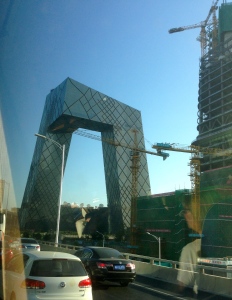 China is not, definitely not, a third world country. Since the 1980’s China has promoted a freer market-based economy. Over the past decades average annual growth rates of GDP and PPP have surpassed every other economy in the world. Most years, GDP growth has exceeded 10%, lately the average has exceeded 6-7%. Astounding numbers when we consider Canada’s GDP growth rate is less than 3%. Image shattered.
China is not, definitely not, a third world country. Since the 1980’s China has promoted a freer market-based economy. Over the past decades average annual growth rates of GDP and PPP have surpassed every other economy in the world. Most years, GDP growth has exceeded 10%, lately the average has exceeded 6-7%. Astounding numbers when we consider Canada’s GDP growth rate is less than 3%. Image shattered.  There is a vibrant feeling of optimism everywhere, entrepreneurship abounds, hard work is evident – as close as the door to my Beijing hotel. On my first morning, I walked out the door of my hotel and found a small hole-in-the-wall place selling baozi – steamed buns. I bought three, for the nominal sum of about $2.50 and sat down on some steps to enjoy them. There was a constant lineup, from 6 am till late in the evening.
There is a vibrant feeling of optimism everywhere, entrepreneurship abounds, hard work is evident – as close as the door to my Beijing hotel. On my first morning, I walked out the door of my hotel and found a small hole-in-the-wall place selling baozi – steamed buns. I bought three, for the nominal sum of about $2.50 and sat down on some steps to enjoy them. There was a constant lineup, from 6 am till late in the evening.
